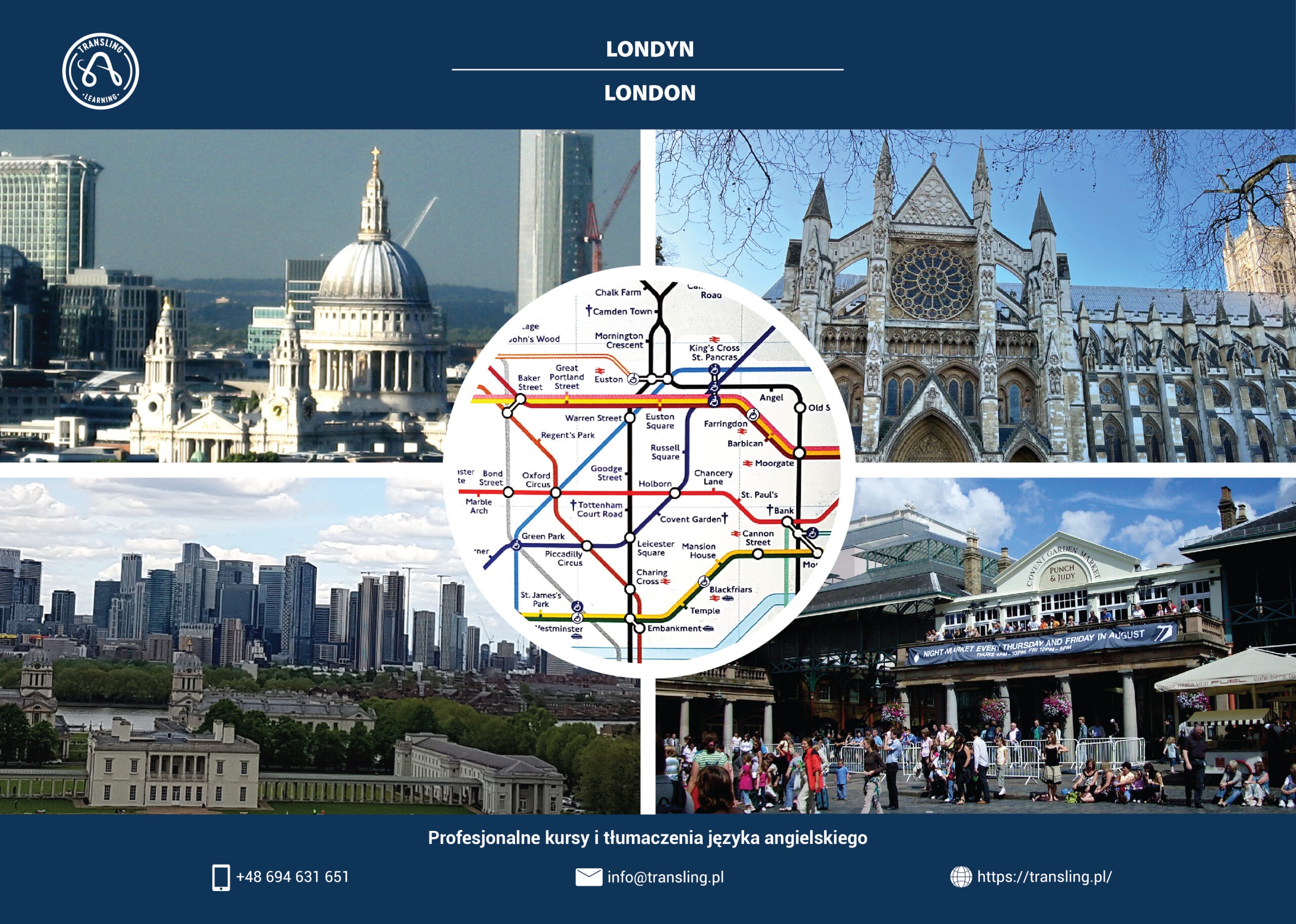Londyn
London
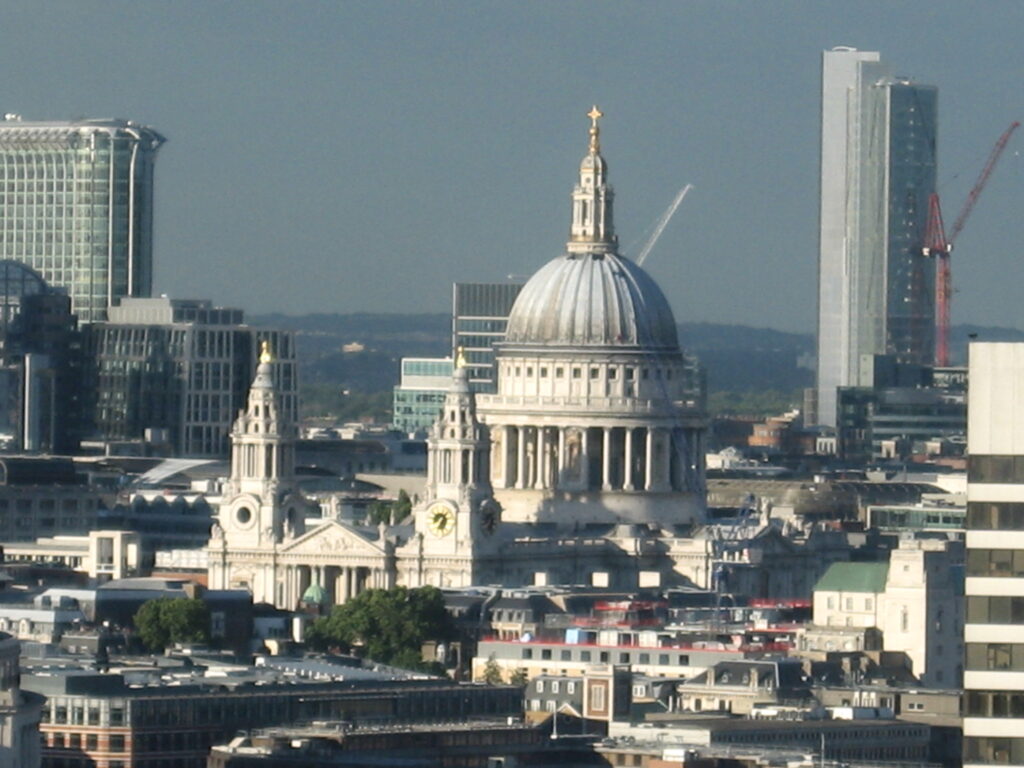



When a man is tired of London, he is tired of life. – Dr Samuel Johnson
Ta myśl wypowiedziana już w XVIII wieku przez Samuela Johnsona trafnie oddaje klimat brytyjskiej stolicy a słowa nadal mocno rezonują.
Z okazji zbliżającego się sezonu wakacyjnego, w tym miesiącu i również kolejnym zapraszam do lektury z cyklu „Wokół krajów anglojęzycznych”. Temat na czerwiec to stolica Zjednoczonego Królestwa Brytyjskiego czyli Londyn.
Londyn od wieków fascynował i przyciągał swą atrakcyjnością, architekturą, bogactwem zabytków, dorobkiem kulturalnym, bogatym życiem nocnym, otwartością na wielokulturowość. To swoisty tygiel narodów, mikroświat gdzie w jednym miejscu możemy niejako dotknąć kosmopolityczności i wielonarodowości.
Nie sposób zliczyć ile razy odwiedziłam już stolicę Wielkiej Brytanii ale na pewno liczba jest już dwucyfrowa. Jako wielokrotna bywalczyni i dawna mieszkanka tej największej angielskiej metropolii, postaram się przybliżyć najatrakcyjniejsze miejsca warte odwiedzenia podczas jednego dłuższego weekendu… lub raczej jego dwukrotności, gdyż aby dokładniej zwiedzić poniższe fascynujące miejsca należy poświęcić zdecydowanie więcej czasu niż 2 dni.
This thought, expressed already in the 18th century by Samuel Johnson, accurately reflects the atmosphere of the British capital, and the words still resonate strongly.
As the holiday season is coming closer, this month and also next one, in the series „Around English-speaking countries”, I will focus on presenting the most iconic places in the countries where English is used as the first language. The topic for June is the capital of the United Kingdom of Great Britain and Northern Ireland i.e. London.
London has fascinated and attracted people for centuries with its attractiveness, architecture, wealth of monuments, cultural heritage, rich nightlife and openness to multiculturalism. It is a kind of melting pot of nations, a micro-world where in one place we can somehow come into contact with cosmopolitanism and multinationalism.
It is virtually impossible to count how many times I have visited the capital of Great Britain, but the number is certainly in double digits. As a frequent visitor and resident of this largest English metropolis, I will try to present the most attractive places worth visiting during one long weekend… or rather twice as long, because to visit the following fascinating places in detail, you need to spend much more time than just 2 days.
CO WARTO LUB TRZEBA ZOBACZYĆ
WHAT IS THERE TO SEE
Większość najważniejszych i najbardziej charakterystycznych zabytków w Londynie skoncentrowana jest wokół Tamizy, największej rzeki przepływającej przez miasto.
Wysiadając na stacji metra Westminster można zobaczyć większość najistotniejszych obiektów stanowiących główne atrakcje turystyczne.
The vast majority of the most important and characteristic monuments in London are concentrated around the Thames, the largest river flowing through the city. When you get off at Westminster tube station, you can see most of the most important tourist attractions.
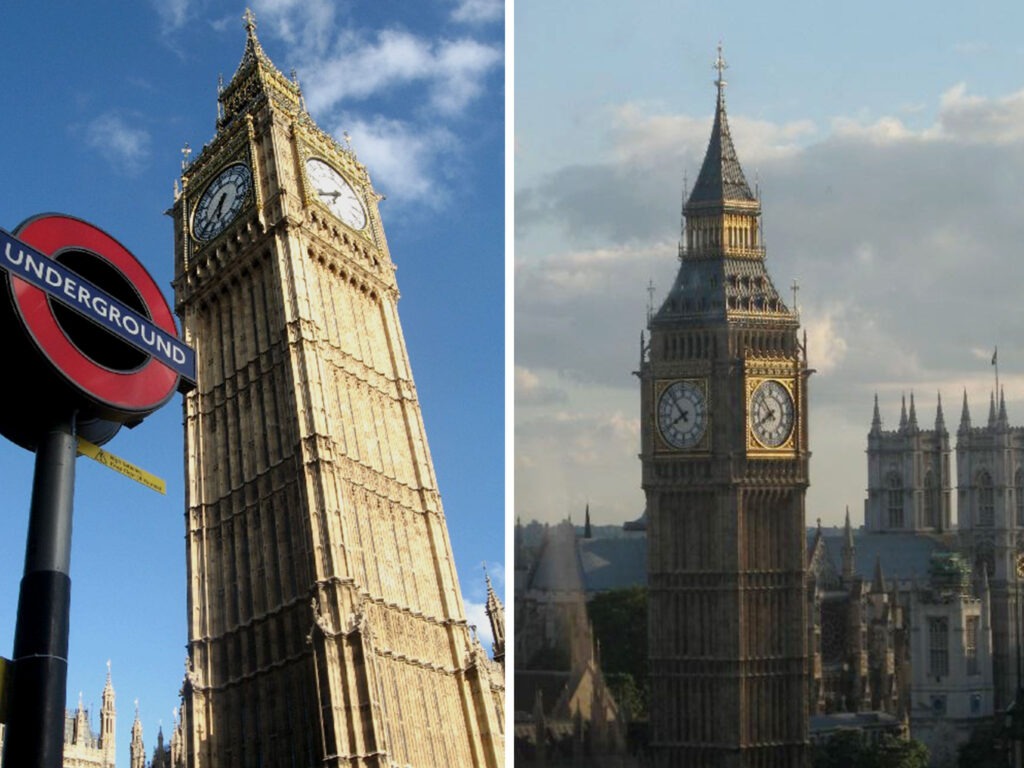
BIG BEN – to bez wątpienia wizytówka Londynu i najbardziej charakterystyczny obiekt na mapie turystycznej stolicy, swoisty symbol Wielkiej Brytanii. Nazwa początkowo dotyczyła tylko dzwonu ze St. Stephen’s Tower (Wieża św. Szczepana) natomiast obecnie Big Ben odnosi się często zarówno do dzwonu, jak i zegara oraz samej wieży. Zegar został zbudowany w 1854 roku a w 2012 roku wieża została oficjalnie nazwana Elizabeth Tower dla uhonorowania 60-letniego panowania Elżbiety II.
BIG BEN – this is undoubtedly one of London’s main landmarks and the most characteristic object on the capital’s tourist map, a symbol of Great Britain. The name initially referred to the bell from St. Stephen’s Tower, also known as The Clock Tower, belonging to the Palace of Westminster. Nowadays, however, the name Big Ben often refers to both the bell, the clock and the tower itself. The clock was built in 1854 and in 2012, the tower was officially named the Elizabeth Tower to honour the 60-year reign of Elizabeth II.

PAŁAC WESTMINSTER – to budynek brytyjskiego parlamentu, siedziba brytyjskiej Izby Gmin, Izby Lordów oraz urzędów z nimi związanych. Ten zabytkowy, neogotycki pałac usytuowany nieopodal Big Ben’a będący architektonicznym arcydziełem, został wpisany w 1987 roku na Listę Światowego Dziedzictwa UNESCO.
Poniżej widok na Pałac Westminster widziany z kapsuły London Eye (wielkiego koła znajdującego się po drugiej stronie Tamizy) oraz z bliższej perspektywy.
THE PALACE OF WESTMINSTER – the building of the British Parliament, the seat of the British House of Commons, the House of Lords and related offices. This historic, neo-Gothic palace located near Big Ben, which is a real architectural masterpiece, was included in the UNESCO World Heritage List in 1987. Below is a view of the Palace of Westminster as seen from the London Eye capsule (the large wheel located on the other side of the Thames) as well as from a closer perspective.
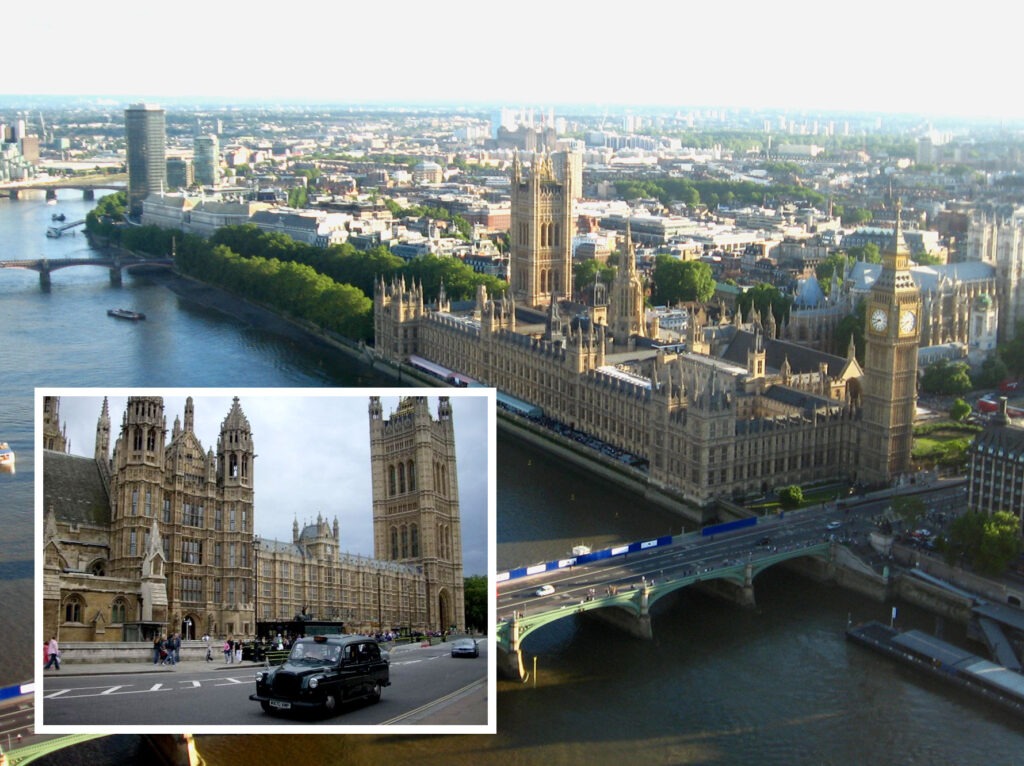
OPACTWO WESTMINSTER (Westminster Abbey) – to najważniejsza, obok katedry w Canterbury i katedry św. Pawła świątynia anglikańska. Począwszy od Wilhelma Zdobywcy (Wiliam the Conqueror, 1066), opactwo to jest miejscem koronacji królów Anglii i królów Wielkiej Brytanii, z wyjątkiem Edwarda V i Edwarda VIII, którzy nie byli koronowani. Od XIII wieku opactwo stanowi również miejsce pochówku królów oraz innych zasłużonych osób dla państwa.
WESTMINSTER ABBEY – is the most important, next to Canterbury Cathedral and St. Paul’s Cathedral, Anglican church. Beginning with William the Conqueror (1066), the abbey has been the site of the coronation of Kings of England and Kings of Great Britain, with the exception of Edward V and Edward VIII, who were not crowned. Since the 13th century, the abbey has also been the burial place of kings and other distinguished persons for the whole country.

LONDON EYE – nazywane również Millennium Wheel (Koło Milenijne) – to koło obserwacyjne zbudowane w 1999 roku z okazji nowego tysiąclecia. Koło mieści się w dzielnicy Lambeth, na południowym brzegu Tamizy, nieopodal mostu Westminster. Wysokość koła to 135m, a jego pełny obrót trwa ok. 30 minut i tyle właśnie trwa cała przejażdżka, której koszt to ok. 30 funtów czyli ok. 150 zł. Na kole znajdują się 32 klimatyzowane kapsuły pasażerskie, z których rozpościera się niesamowity widok na panoramę miasta. Co ciekawe, liczba tych kapsuł nie jest przypadkowa, ponieważ nawiązuje do liczby dzielnic (gmin) Londynu, których jest właśnie 32. Prędkość liniowa tych kabin jest niewielka co umożliwia wsiadanie i wysiadanie bez zatrzymywania koła. Koło budowane było sekcjami, których części transportowane były Tamizą a oficjalnego otwarcia dokonał ówczesny premier Wielkiej Brytanii Tony Blair 31 grudnia 1999 roku.
LONDON EYE – also called the Millennium Wheel – is an observation wheel built in 1999 on the occasion of the new millennium. The wheel is located in the district of Lambeth, on the south bank of the Thames, near Westminster Bridge. The height of the wheel is 135 m, and its full revolution takes about 30 minutes, which is how long the entire ride lasts, the cost of which is about £30, i.e. about PLN 150. There are 32 air-conditioned passenger capsules on the wheel, which offer an amazing view of the city skyline. Interestingly, the number of these capsules is not accidental, because it refers to the number of districts (municipalities or boroughs) of London, of which there are 32. The linear speed of these cabins is low, which allows getting on and off without stopping the wheel. The wheel was built in sections, parts of which were transported along the Thames, and was officially opened by the then British Prime Minister Tony Blair on 31st December 1999 to celebrate the new millennium.

THE GLOBE – to jeden z najbardziej charakterystycznych architektonicznie i najstarszych teatrów w Londynie zbudowany w 1599 na południowym brzegu Tamizy. Teatr ten działał w latach 1599-1642, a założyli go bracia Burbage natomiast jednym z udziałowców był William Szekspir. To właśnie premiery jego utworów były tam wystawiane jak również sztuki Bena Jonsona i Johna Webstera. W ówczesnym czasie aktorami byli wyłącznie mężczyźni, role żeńskie również były odgrywane przez mężczyzn a wszelkie sztuki można było zobaczyć tylko na stojąco. W 1613 r. teatr niestety spłonął w pożarze, jednak szybko go odbudowano bowiem już rok później, w 1614 roku. Wskutek interwencji purytanów budynek został zamknięty w 1642 roku, a dwa lata później został całkowicie zburzony. Cała budowla została zrekonstruowana i otwarta w 1997 roku. Obecnie w The Globe można zobaczyć przede wszystkim sztuki Wiliama Szekspira, uważanego za narodowego poetę Anglii.
THE GLOBE – one of the most architecturally distinctive and oldest theatres in London, built in 1599 on the south bank of the Thames. The theatre operated in the years 1599-1642. It was founded by the Burbage brothers, and one of the shareholders was William Shakespeare. The premieres of his works were performed there, as well as plays by Ben Jonson and John Webster. At that time, only men were actors, female roles were also played by men, and all plays could only be seen standing. In 1613, the theatre unfortunately burned down in a fire, but it was quickly rebuilt a year later, in 1614. Due to the intervention of the Puritans, the building was closed in 1642, and two years later it was completely demolished. The entire building was reconstructed and opened in 1997. Currently, The Globe shows mainly the plays of William Shakespeare, who is considered the national poet of England.

TOWER BRIDGE – to most zwodzony (niekiedy mylony z sąsiednim London Bridge) przeprowadzony przez Tamizę w pobliżu Tower of London, od której właśnie wziął swą nazwę. Most został ukończony w 1894 roku i niewątpliwie jest to jeden z najbardziej znanych obiektów w Londynie, zbudowany w stylu wiktoriańskim. Tower Bridge jest mostem umożliwiającym przepływanie statków oceanicznych do ok. 40,5 m wysokości powyżej poziomu wody. Charakterystycznym elementem mostu są dwie wieże główne, połączone u góry dwoma pomostami stanowiącymi kładki dla pieszych, które są zawieszone 34 m nad jezdnią i ponad 44 m nad oznaczeniem górnego poziomu w rzece. Na moście mieści się obecnie wystawa Tower Bridge z interaktywnymi wystawami przybliżającymi historię mostu. Do dziś jest to niewątpliwie jeden z najbardziej charakterystycznych i rozpoznawalnych symboli Londynu.
TOWER BRIDGE – a drawbridge (sometimes confused with the neighbouring London Bridge) crossing the Thames near the Tower of London, from which it takes its name. The bridge was completed in 1894 and is undoubtedly one of the most famous structures in London, built in the Victorian style. Tower Bridge is a bridge enabling the passage of ocean ships up to approximately 40.5 m above the water level. A characteristic element of the bridge are the two main towers, connected at the top by two platforms constituting pedestrian bridges, which are suspended 34 m above the road and over 44 m above the upper level marking in the river. The bridge currently houses the Tower Bridge exhibition with interactive displays explaining the history of the bridge. To this day, it is undoubtedly one of the most characteristic and recognizable symbols of London.
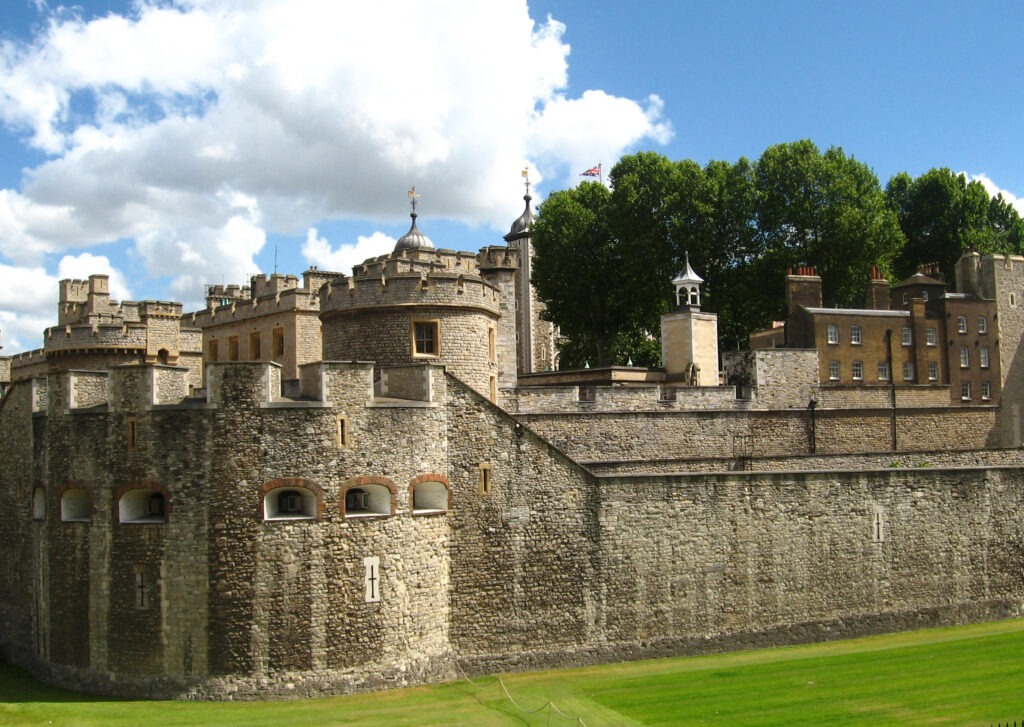
THE TOWER OF LONDON – to popularna atrakcja turystyczna Londynu, położona nad północnym brzegiem Tamizy, otoczona kilkoma rzędami murów i dawnym korytem fosy, w którym obecnie rośnie trawa. Wieża została wzniesiona w 1078 dla Williama Zdobywcy (William the Conqueror). W swej historii budynek był fortecą, więzieniem, pałacem, mennicą a nawet służył jako zoo. Wieża pilnowana jest przez charakterystycznie ubranych strażników, nazywanych Yeomen Warders, a popularnie beefeaterami (ang. beefeater oznacza zjadacz wołowiny). W twierdzy są obecnie przechowywane liczne zbroje, broń, klejnoty oraz insygnia koronacyjne. Twierdza Tower jest do dziś zamieszkana a jej społeczność tworzą strażnicy Yeomen Warders wraz z rodzinami, naczelnik twierdzy, urzędnicy oraz kapelan i lekarz. Symbolem Tower of London są kruki. Legenda głosi, że imperium brytyjskie upadnie gdy kruki opuszczą twierdzę.
THE TOWER OF LONDON – a popular tourist attraction in London, located on the north bank of the Thames, surrounded by several rows of walls and a former moat bed where grass now grows. The tower was built in 1078 for William the Conqueror. Throughout its history, the building was a fortress, a prison, a palace, a mint and even served as a zoo. The tower is guarded by characteristically dressed guards, called Yeomen Warders, or more popularly known as beefeaters. The tower currently houses numerous armour, weapons, jewels and coronation insignia. The Tower Fortress is still inhabited today and its community consists of Yeomen Warders and their families, the fortress’s chief, officials, a chaplain and a doctor. The symbol of the Tower of London is ravens. Legend has it that the British Empire will fall when the ravens leave the tower.

THE SHARD – to charakterystyczny wieżowiec w Londynie w kształcie piramidy, usytuowany w dzielnicy Southwark, na południowym brzegu Tamizy. Budynek został zaprojektowany przez włoskiego architekta i ukończony w 2012 roku. Przez kilka miesięcy po ukończeniu był najwyższym budynkiem w Europie, którego wysokość wynosi 309,6 metrów. The Shard posiada 72 piętra i mieszczą się tam biura (na niższych kondygnacjach), obiekty gastronomiczne (restauracje), hotel, mieszkania (na wyższych kondygnacjach). Szczyt obiektu (ostatnie piętra) przeznaczony jest na taras widokowy dla zwiedzających.
THE SHARD – a characteristic pyramid-shaped skyscraper in London, located in the Southwark district, on the south bank of the Thames. The building was designed by an Italian architect and completed in 2012. For several months after completion, it was the tallest building in Europe, standing at 309.6 meters high. The Shard has 72 floors and houses offices (on the lower floors), catering facilities (restaurants), a hotel and apartments (on the upper floors). The top of the building (top floors) is intended as an observation deck for visitors.
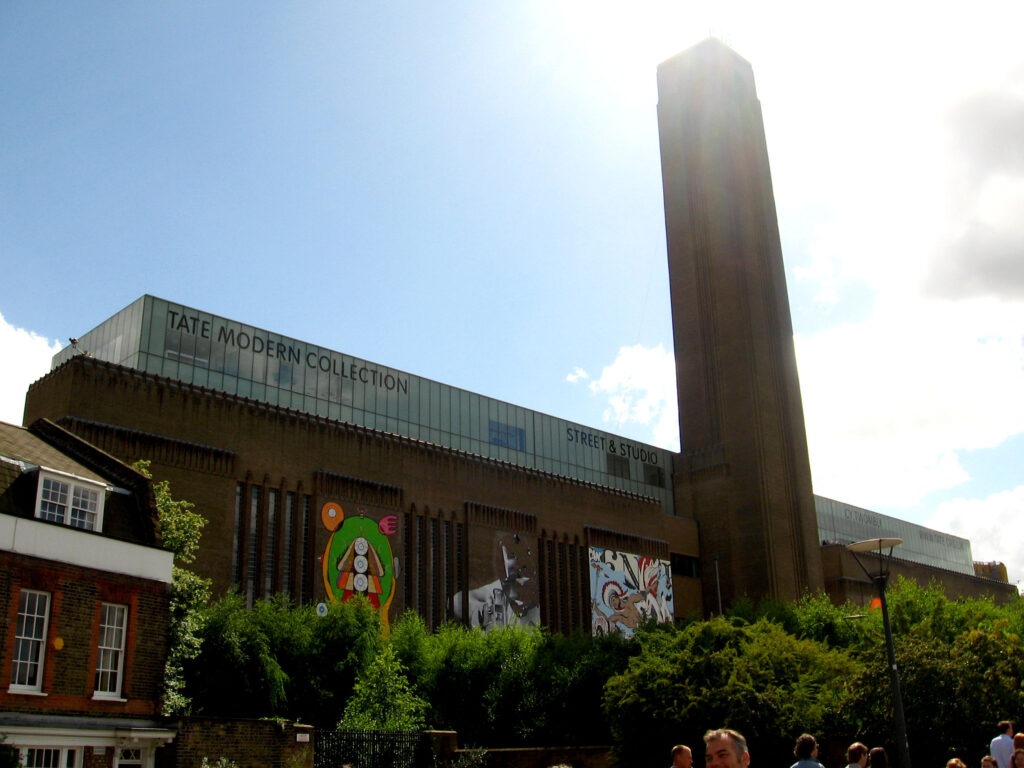
TATE MODERN – jest jednym z największych muzeów sztuki współczesnej na świecie. Muzeum Tate Modern mieści się w dawnej elektrowni Bankside, czego dowodem jest typowa industrialna architektura z charakterystycznym kominem. Budynek powstawał w dwóch etapach w latach 1947–1963 i w swojej kolekcji ma dzieła sztuki brytyjskiej datowane od 1900 roku oraz prace twórców spoza Wielkiej Brytanii. To tutaj znajdują się prace m.in.: Pabla Picassa, Henriego Matisse’a, Andy’ego Warhola, Salvadora Dalego, Jacksona Pollocka. Co roku muzeum przyciąga miliony turystów z całego świata. Wstęp do muzeum jest bezpłatny.
TATE MODERN – one of the largest museums of contemporary art in the world. The Tate Modern museum is located in the former Bankside power station, as evidenced by its typical industrial architecture with a characteristic chimney. The building was built in two stages between 1947 and 1963 and its collection includes works of British art dating back to 1900 as well as works by artists from outside Great Britain. This is where you can find works by, among others, Pablo Picasso, Henri Matisse, Andy Warhol, Salvador Dali, Jackson Pollock. Every year, the museum attracts millions of tourists from all over the world. Admission to the museum is free.
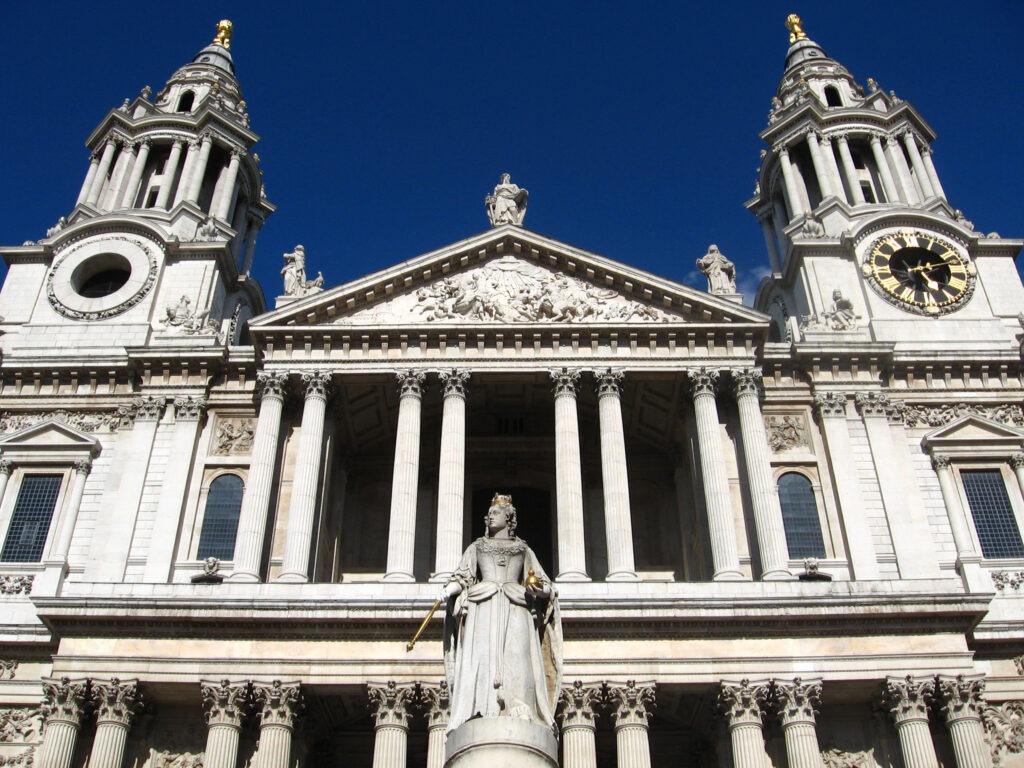
ST. PAUL’S CATHEDRAL – to jeden z najbardziej znanych kościołów anglikańskich w Wielkiej Brytanii i budowli Londynu zlokalizowany w centrum dzielnicy City of London i formalnie pełni funkcję głównej świątyni tej dzielnicy. Jej budowę ukończono w 1710. Katedra była miejscem wielu słynnych pogrzebów (np. admirała Nelsona, księcia Wellingtona, Winstona Churchilla i Margaret Thatcher). Pogrzeby, śluby i inne ceremonie kościelne brytyjska rodzina królewska organizuje zazwyczaj w Westminster Abbey, ale to w katedrze św. Pawła odbył się ślub księcia Walii – Karola Windsora i lady Diany Spencer.
ST. PAUL’S CATHEDRAL – one of the most famous Anglican churches in Great Britain and buildings in London, located in the centre of the City of London and formally serves as the main temple of this district. Its construction was completed in 1710. The cathedral was the site of many famous funerals (e.g. Admiral Nelson, Duke of Wellington, Winston Churchill and Margaret Thatcher). The British royal family usually organises funerals, weddings and other church ceremonies in Westminster Abbey, but it is in St. Paul’s Cathedral where the wedding of Prince Charles and Lady Diana took place.

Idąc w drugą stronę od Big Ben’a wzdłuż Downing Street (siedziby premiera Wielkiej Brytanii) oraz Whitehall dojdziemy do kolejnych ważnych atrakcji turystycznych Londynu, jakimi są:
BUCKINGHAM PALACE – oficjalna londyńska rezydencja brytyjskich monarchów, zlokalizowana w City of Westminster. To największy na świecie pałac królewski, który od 1837 roku pełni funkcję oficjalnej siedziby monarszej. Jest to tym samym jedna z pereł architektury późnego baroku. Pałac został zbudowany w 1703 roku jako rezydencja miejska dla księcia Buckingham, Johna Sheffielda. W roku 1761 król Jerzy III (George III) wszedł w posiadanie pałacu, który został przekształcony w jego rezydencję prywatną. W ciągu kolejnych 75 lat pałac wielokrotnie rozbudowywano. Obecnie w pałacu mieści się sześćset komnat, w tym dziewiętnaście reprezentacyjnych, ponad siedemdziesiąt łazienek i prawie dwieście sypialni. Przed siedzibą obecnego króla znajduje się pomnik królowej Wiktorii (Victoria Memorial), która przeznaczyła pałac na prywatną stałą rezydencję królewską. Pałac Buckingham jest także miejscem uroczystości państwowych oraz oficjalnych spotkań głów państw. Dla Brytyjczyków pałac stanowi symbol Wielkiej Brytanii.
Walking in the other direction from Big Ben along Downing Street (the seat of the British Prime Minister) and Whitehall, we will reach other important tourist attractions in London, which are:
BUCKINGHAM PALACE – the official London residence of the British monarchs, located in the City of Westminster. It is the largest royal palace in the world and has been the official residence of the monarch since 1837. It is therefore one of the pearls of late baroque architecture. The palace was built in 1703 as a town residence for the Duke of Buckingham, John Sheffield. In 1761, King George III took possession of the palace, which was transformed into his private residence. Over the next 75 years, the palace was expanded many times. Currently, the palace houses six hundred rooms, including nineteen representative ones, over seventy bathrooms and almost two hundred bedrooms. In front of the current king’s residence there is a monument to Queen Victoria (Victoria Memorial), who designated the palace as a private permanent royal residence. Buckingham Palace is also a place of state ceremonies and official meetings of heads of state. For the British, the palace is a symbol of Great Britain.

KENSINGTON PALACE – to królewska rezydencja w Kensington Gardens w dzielnicy Royal Borough of Kensington and Chelsea w Londynie. Pałac ten stanowi rezydencję brytyjskiej rodziny królewskiej od XVII wieku.
OGRODY KENSINGTON – to jeden z ośmiu parków królewskich w Londynie. Większość parku położona jest w dzielnicy City of Westminster z wyjątkiem niewielkiego obszaru w zachodniej części parku, który leży w dzielnicy Royal Borough of Kensington and Chelsea. Park ma powierzchnię ok. 275 akrów (111,3 ha) i znajduje się w nim m.in. pomnik Albert Memorial.
KENSINGTON PALACE – a royal residence in Kensington Gardens in the Royal Borough of Kensington and Chelsea in London. This palace has been the residence of the British royal family since the 17th century.
KENSINGTON GARDENS – one of eight royal parks in London. Most of the park is located in the City of Westminster, except for a small area in the western part of the park, which is in the Royal Borough of Kensington and Chelsea. The park has an area of more than 110 hectares and includes, among others, Albert Memorial .

Naprzeciwko Albert Memorial mieści się Royal Albert Hall czyli sala koncertowa poświęcona mężowi królowej Wiktorii, księciu Albertowi. Sala została otwarta w 1871 roku i na przestrzeni lat pełniła funkcję wszelkich wydarzeń kulturalnych, koncertów, konferencji, balów. To tutaj odbyły się również finał konkursu Miss World a nawet imprezy sportowe.
Opposite the Albert Memorial is the Royal Albert Hall, a concert hall dedicated to Queen Victoria’s husband, Prince Albert. The hall was opened in 1871 and over the years it has served as a venue for all kinds of cultural events, concerts, conferences and balls. It was here that the finals of the Miss World competition and even sporting events took place.
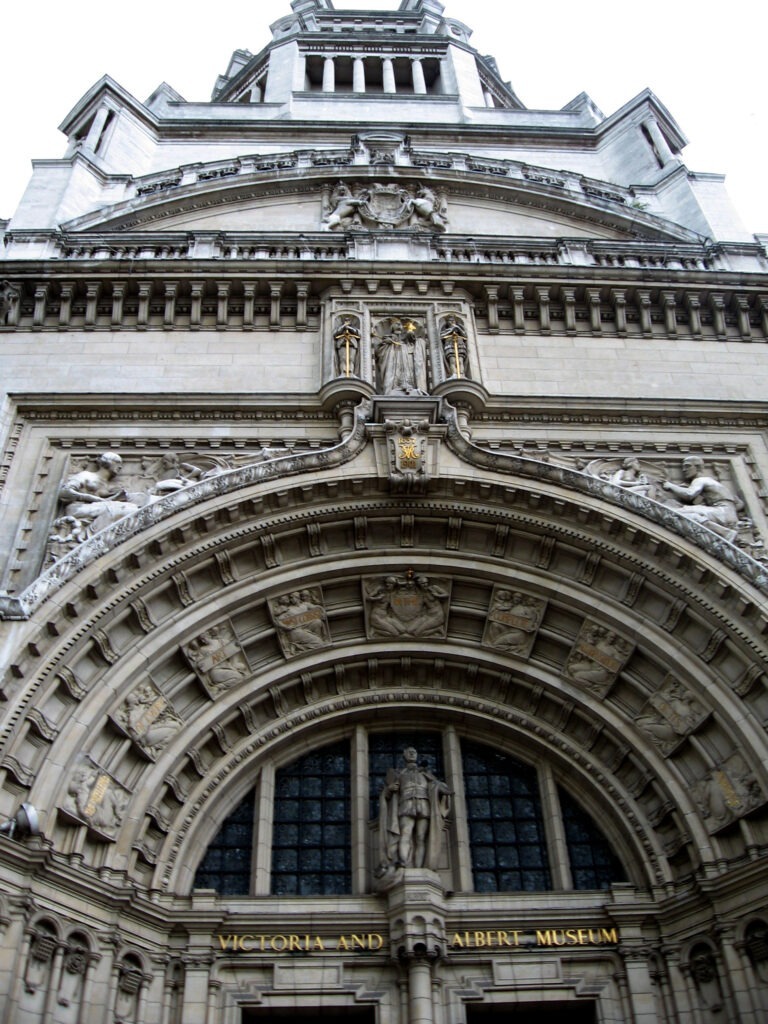
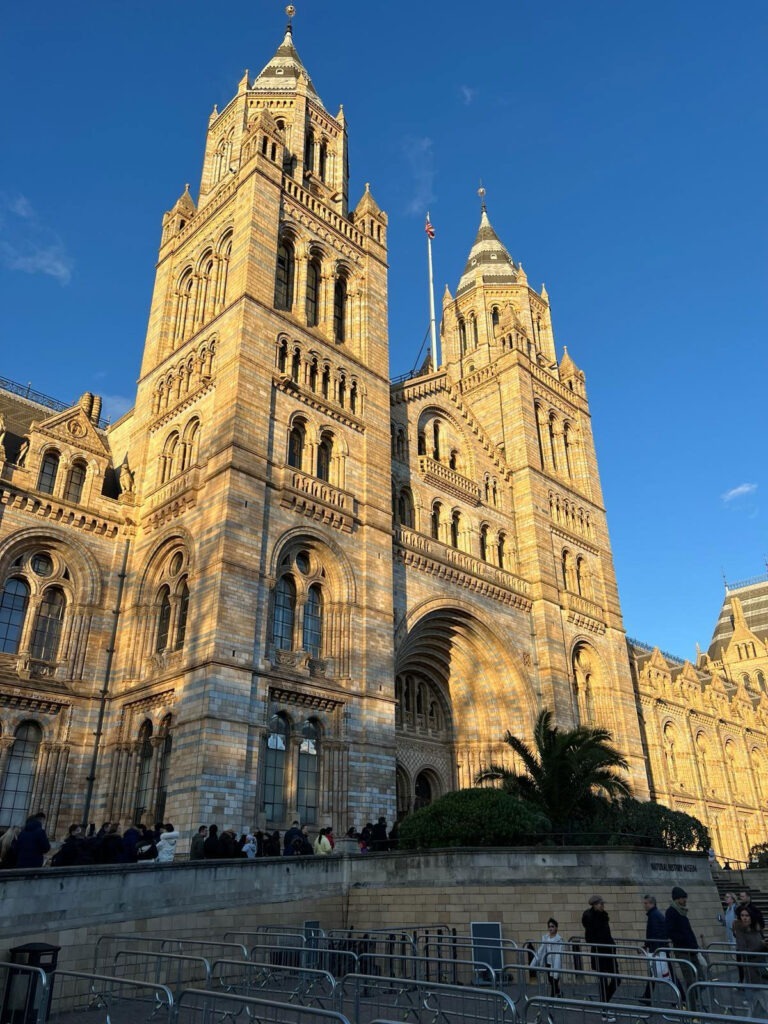

KOMPLEKS MUZEÓW W DZIELNICY KENSINGTON:
MUZEUM HISTORII NATURALNEJ – jest jednym z trzech wielkich muzeów znajdujących się przy Exhibition Road w South Kensington (inne to Science Museum oraz Muzeum Wiktorii i Alberta). Oficjalne otwarcie odbyło się w 1881. Kolekcja muzeum liczy ponad 70 milionów eksponatów, a całość dzieli się na 5 głównych działów: botanika, entomologia, mineralogia, paleontologia i zoologia. Dużą popularnością cieszy się symulowane trzęsienie ziemi, którego mogą doświadczyć zwiedzający oraz galeria dinozaurów, gdzie znajduje się ryczący, ruchomy dinozaur-robot. Od 1979 do 2017 w głównym holu znajdował się odlew szkieletu wielkiego dinozaura (diplodoka) a obecnie znajduje się tam szkielet płetwala błękitnego. W muzeum tym można wielu eksponatów dotknąć, spróbować, wykonać różne symulacje i eksperymenty, a całość jest głównie przeznaczona dla młodszych, choć starsi też mogą się wiele nauczyć. Znajduje się tam m.in. kolekcja ryb, płazów, gadów, ptaków i ssaków w różnych stadiach ewolucji. Na samym szczycie galerii znajduje się plaster wycięty z pnia sekwoi o średnicy 6 metrów.
- MUZEUM VICTORII I ALBERTA – to największe muzeum sztuki i rzemiosła artystycznego w Londynie, usytuowane w pobliżu Muzeum Historii Naturalnej i Muzeum Nauki, między stacjami South Kensington a Knightsbridge. Nazwa pochodzi od królowej Wiktorii i jej męża, księcia Alberta. Stała kolekcja liczy ponad 4,5 mln eksponatów i obejmuje przedmioty powstałe na przestrzeni 5000 lat, pochodzące z Europy, Ameryki Północnej, Azji i Afryki Północnej. Są to rzeźby, obrazy, rysunki, fotografie, książki, ceramika, meble, tkaniny, stroje, wyroby ze szkła i metalu, biżuteria itd.
MUZEUM NAUKI – to trzecie muzeum w South Kensington znajdujące się nieopodal Muzeum Victorii i Alberta. W muzeum nauki i techniki znajdziemy ponad 300 000 eksponatów – od najmniejszych układów elektronicznych po naturalnej wielkości samoloty.
Bilety do powyższych muzeów są bezpłatne.
MUSEUM COMPLEX IN THE KENSINGTON DISTRICT:
- NATURAL HISTORY MUSEUM – one of three great museums located on Exhibition Road in South Kensington (the others being the Science Museum and the Victoria and Albert Museum). The official opening took place in 1881. The museum’s collection has over 70 million exhibits, and the whole is divided into 5 main sections: botany, entomology, mineralogy, paleontology and zoology. The simulated earthquake that visitors can experience and the dinosaur gallery with a roaring, moving robot dinosaur are very popular. From 1979 to 2017, the main hall housed a cast of the skeleton of a large dinosaur (diplodocus), and currently there is a skeleton of a blue whale. In this museum you can touch many exhibits, try them out, perform various simulations and experiments, and the whole thing is mainly intended for younger people, although older ones can also learn a lot. There is, for example, a collection of fish, amphibians, reptiles, birds and mammals in various stages of evolution. At the very top of the gallery there is a slice cut from a redwood trunk with a diameter of 6 meters.
VICTORIA AND ALBERT MUSEUM – is London’s largest arts and crafts museum, situated close to the Natural History Museum and the Science Museum, between South Kensington and Knightsbridge stations. The name comes from Queen Victoria and her husband, Prince Albert. The permanent collection has over 4.5 million exhibits and includes objects dating back 5,000 years, coming from Europe, North America, Asia and North Africa. These are sculptures, paintings, drawings, photographs, books, ceramics, furniture, fabrics, clothes, glass and metal products, jewelry, etc.
- SCIENCE MUSEUM – is the third museum in South Kensington, located close to the Victoria and Albert Museum. The museum of science and technology houses over 300,000 exhibits – from the smallest electronic systems to life-size airplanes.
Admission to the above museums is free.
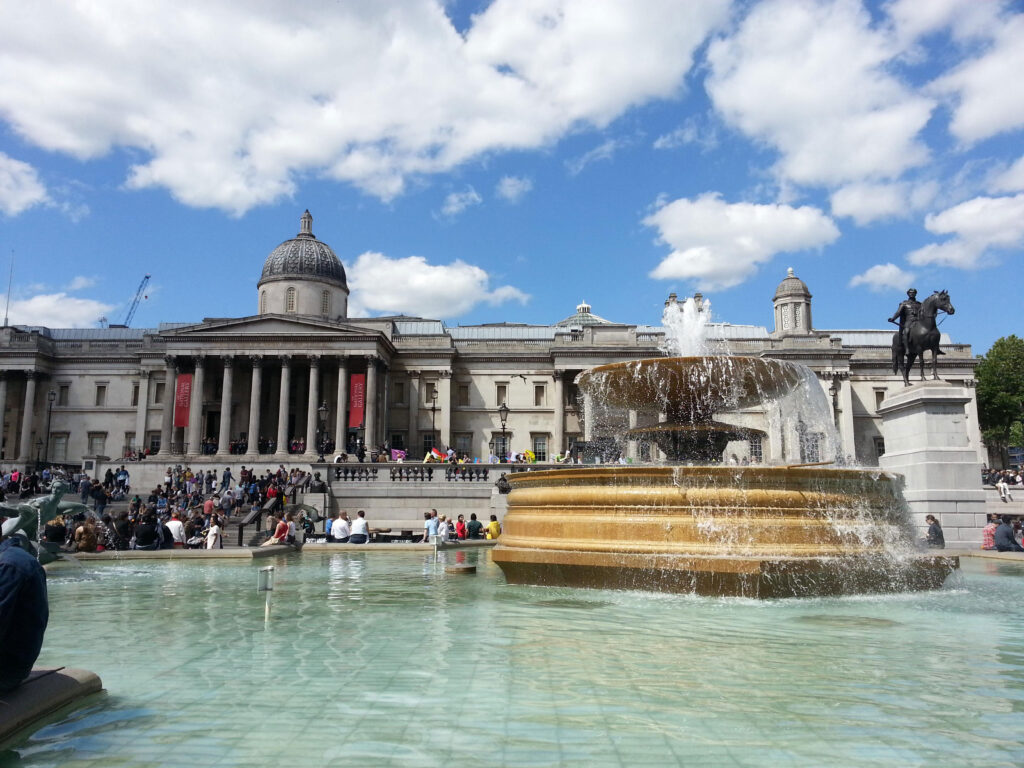
TRAFALGAR SQUARE – to słynny plac w Londynie, usytuowany w City of Westminster, wytyczony w 1826 według projektu Johna Nasha w miejscu dawnych stajni królewskich. Nazwa placu nawiązuje do zwycięstwa Royal Navy w morskiej bitwie pod Trafalgarem (1805) a jego upamiętnieniem jest 55-metrowa kolumna admirała Nelsona, który przyczynił się do pokonania floty francuskiej i triumfu floty brytyjskiej. Oprócz kolumny Nelsona (ustawionej w 1843 r.) na placu znajdują się także pomniki króla Jerzego IV, gen. Havelocka i gen. Napiera oraz fontanny sir Lutyensa. Kolumny i fontann strzegą cztery lwy odlane z brązu. Na północnej stronie placu mieści się budynek National Gallery gdzie również warto wstąpić i przyjrzeć się bogatym dziełom sztuki. W galerii można podziwiać kolekcję ponad 2000 dzieł malarstwa, głównie zachodnioeuropejskiego, w tym zbiór obrazów sławnych francuskich impresjonistów i Vincenta van Gogha.
TRAFALGAR SQUARE – a famous square in London, located in the City of Westminster, marked out in 1826 according to the design of John Nash on the site of the former royal stables. The name of the square refers to the victory of the Royal Navy in the naval Battle of Trafalgar (1805) and is commemorated by the 55-meter-high column of Admiral Nelson, who contributed to the defeat of the French fleet and the triumph of the British fleet. In addition to Nelson’s Column (erected in 1843), the square also contains monuments to King George IV, General Havelock and General Napier, and Sir Lutyens’ Fountains. The columns and fountains are guarded by four lions cast in bronze. On the northern side of the square there is the National Gallery building, which it is also worth visiting due to its rich works of art. In the gallery you can admire a collection of over 2,000 works of painting, mainly Western European, including a collection of paintings by famous French impressionists and Vincent van Gogh.
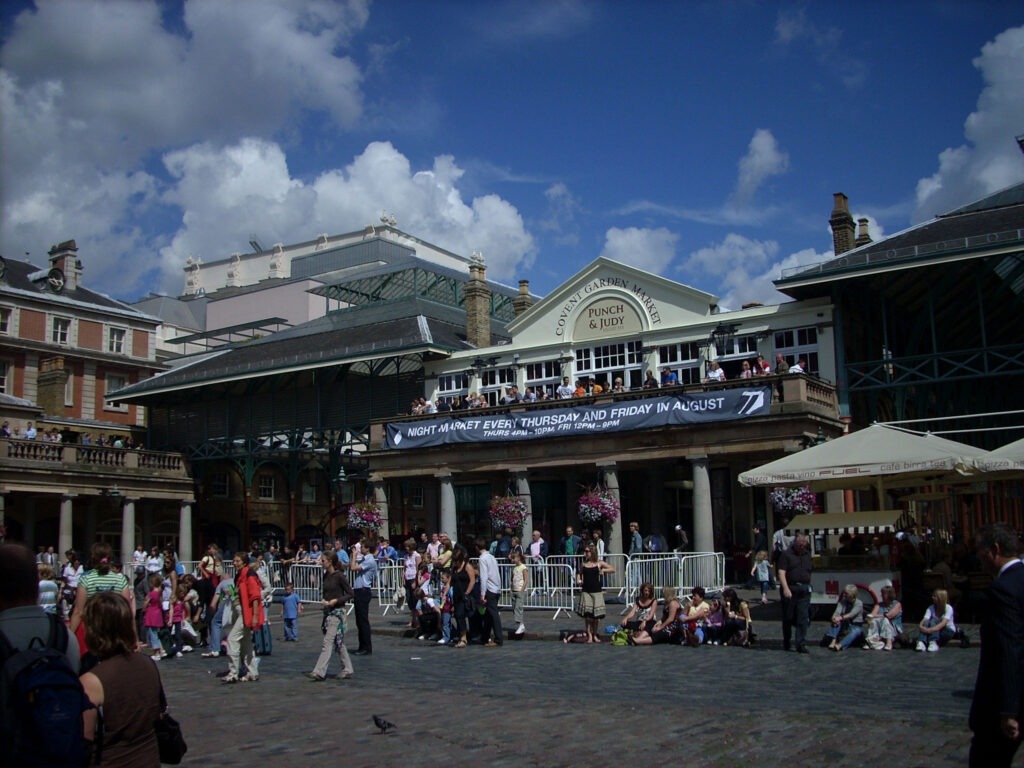
COVENT GARDEN – to dzielnica Londynu położona na terenie gmin City of Westminster oraz London Borough of Camden, najbardziej znana ze spotkań artystów, cyrkowców, muzyków i innych osób związanych ze sztuką. Dawniej znajdował się tutaj klasztor stąd owa nazwa (konwent – ang. convent – Covent). W dzielnicy tej znajduje się Covent Garden Market, gdzie dawniej był tutaj targ warzywno-owocowy, a obecnie mieści się tu centrum handlowe, oraz Royal Opera House, siedziba Opery Królewskiej (The Royal Opera) i Królewskiego Baletu (The Royal Ballet).
COVENT GARDEN – a district of London located within the City of Westminster and the London Borough of Camden, best known for the meetings of artists, circus performers, musicians and other people related to art. There used to be a monastery here, hence the name (convent – Covent). In this district you can see Covent Garden Market, formerly a fruit and vegetable market and now a shopping mall, and the Royal Opera House, home of The Royal Opera and The Royal Ballet.

PICADILLY CIRCUS – to plac i skrzyżowanie głównych ulic w samym sercu teatralnego i rozrywkowego rejonu West End w Londynie, stanowiącego część Soho. Jest to jeden z najbardziej rozpoznawalnych miejsc w Londynie i duża atrakcja turystyczna, która znajduje się w pobliżu głównych punktów handlowych i rozrywkowych West End. Piccadilly Circus jest miejscem rozpoznawalnym na całym świecie, głównie za sprawą świetlnych reklam takich firm jak np. SANYO, McDonald’s czy Coca-Cola, umieszczonym na jednym z rogów placu. Pierwsze tablice reklamowe pojawiły się w tym miejscu w latach 90. XIX wieku. Przy Piccadilly Circus znajdują się m.in. Fontanna poświęcona Earlowi Shaftesbury z figurką Anterosa (oficjalnie i popularnie znana jako Eros), Criterion Theatre oraz London Pavilion.
PICADILLY CIRCUS – a square and intersection of main streets in the heart of the West End theatre and entertainment area in London, part of Soho. It is one of London’s most recognisable landmarks and a major tourist attraction that is close to the West End’s main shopping and entertainment venues. Piccadilly Circus is a place recognisable all over the world, mainly due to the illuminated advertisements of companies such as SANYO, McDonald’s or Coca-Cola, placed on one of the corners of the square. The first advertising boards appeared in this place in the 1890s. At Piccadilly Circus you can see e.g. a fountain dedicated to Earl Shaftesbury with a figure of Anteros (officially and popularly known as Eros), the Criterion Theater and the London Pavilion.

SOHO – to centralna część dzielnicy West End w Londynie, w City of Westminster. W średniowieczu na terenie obecnego Soho znajdowały się ogrody królewskie, a nazwa wzięła się z dawnego okrzyku angielskich myśliwych: so ho! (co w staropolszczyźnie mogło oznaczać hajda! hajże!). Obecnie dzielnica ta znana jest z licznych klubów, dyskotek, restauracji, barów i pubów. Oprócz rozrywkowych lokali otwartych do późna w nocy, zlokalizowane są tu również kompleksy kin, teatry, księgarnie (na Charing Cross Road), modne sklepy oraz salony gier. Wszystko to przyciąga tysiące turystów z całego świata. Soho uchodzi za miejsce w którym widoczny jest tygiel wielokulturowości i wielonarodowości Londynu jako, że dzielnica ta przez wieki przygarniała imigrantów z różnych stron świata. Ponadto Soho jest synonimem przemysłu, handlu, kultury i rozrywki, stanowi bowiem część artystycznego West Endu. Jest strefą zamieszkania zarówno bogaczy, jak i biedniejszych mieszkańców. W obecnych czasach Soho również nawiązuje do otwartości obyczajów co manifestowane jest choćby poprzez dużą liczbą barów dla osób LGBT. Jest w tym samym stopniu dzielnicą chińską (ze względu na Chinatown w jej centrum), historyczną, jak i w opinii niektórych również nieco snobistyczną.
SOHO – the central part of the West End of London, in the City of Westminster. In the Middle Ages, there were royal gardens in what is now Soho, and the name comes from the old cry of English hunters: so ho! (which in Old Polish could mean hajda! hajże!). Currently, this district is known for its numerous clubs, discos, restaurants, bars and pubs. In addition to entertainment venues open until late at night, there are also cinema complexes, theatres, bookshops (on Charing Cross Road), fashionable shops and arcades. All this attracts thousands of tourists from all over the world. Soho is considered a place where the melting pot of London’s multiculturalism and multinationalism is visible, as this district has welcomed immigrants from different parts of the world for centuries. Moreover, Soho is synonymous with industry, commerce, culture and entertainment, as it is part of the artistic West End. It is a residential zone for both rich and poorer residents. Nowadays, Soho also refers to the openness of morals, which is manifested, for example, by the large number of bars for LGBT people. It is both a Chinese district (due to Chinatown in its centre), a historical one, and, in the opinion of some, even a bit snobbish.
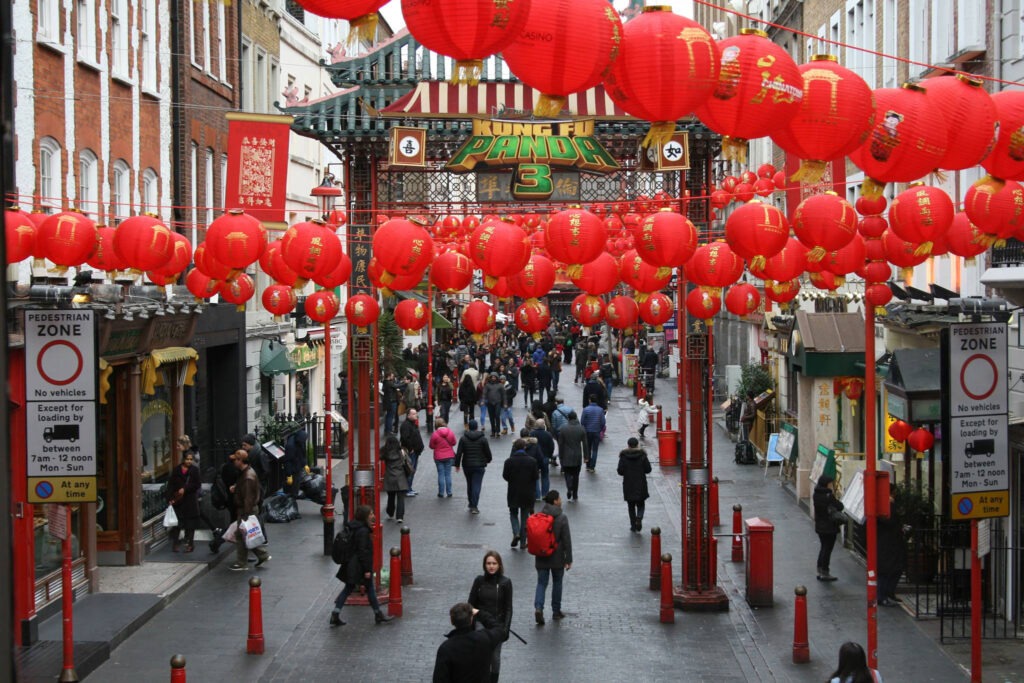
CHINATOWN – czyli chińska dzielnica w Londynie, która mieści się w samym centrum Soho, w rejonie East End. Chińczycy przenieśli się do Soho w połowie XIX wieku. Główną arterią Chinatown jest Gerrard Street gdzie znajdują się najlepsze restauracje, ekskluzywne salony masażu, sklepy z pamiątkami i wiele innych atrakcji. Całą ulicę wypełniają elementy wschodniej architektury takie jak bramy, rzeźby, szyldy i tabliczki w dwóch językach; nad głowami przechodniów zwisają charakterystyczne czerwone lampiony, a całość dopełnia i przyciąga zapach orientalnych przypraw i potraw. Pod koniec stycznia na ulicach tej dzielnicy odbywa się barwny festiwal witania chińskiego Nowego Roku.
CHINATOWN –the Chinese district in London, which is located in the very centre of Soho, in the East End area. The Chinese moved to Soho in the mid-19th century. The main artery of Chinatown is Gerrard Street, where the best restaurants, exclusive massage parlours, souvenir shops and many other attractions are located. The entire street is filled with elements of eastern architecture such as gates, sculptures, signboards and plaques in two languages; characteristic red lanterns hang over the heads of passers-by, and the whole thing is complemented and attracted by the smell of oriental spices and dishes. At the end of January, a colourful festival to welcome the Chinese New Year takes place on the streets of the district.
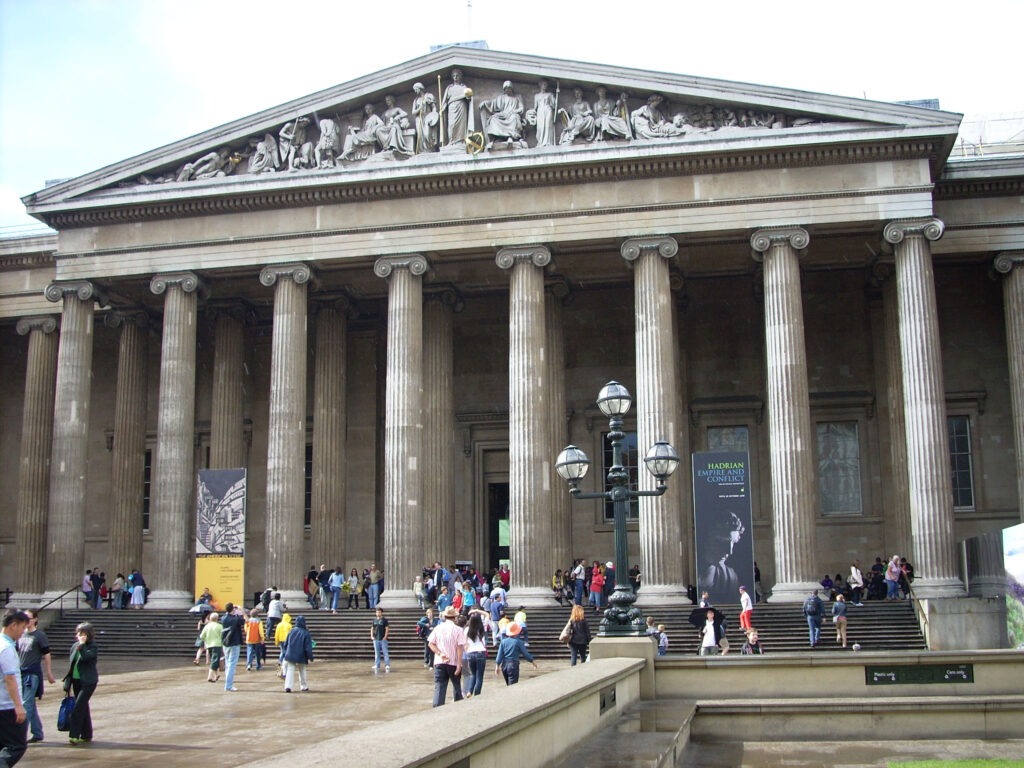
MUZEUM BRYTYJSKIE – to największe muzeum Wielkiej Brytanii i jedno z największych obiektów tego typu na świecie mieszczące się na Great Russel Street w dzielnicy Bloomsbury. Muzeum zostało założone w 1793 roku i obecnie liczy ok. 8 milionów eksponatów z okresu 200 tysięcy lat historii ludzkości. Niektóre z nich zostały zabrane z krajów kolonialnych pod panowaniem brytyjskim, zanim zostały sprzedane, podarowane lub zapisane w testamencie muzeum. Inne zostały nabyte w wyniku prac wykopaliskowych, aukcji, zakupów i donacji. Szczególnie bogate są zbiory archeologiczne oraz etnograficzne. Na mnie osobiście duże wrażenie zrobiła ekspozycja egipska. Wejście do muzeum jest bezpłatne.
BRITISH MUSEUM – the largest museum in Great Britain and one of the largest facilities of this type in the world, located in Great Russell Street in the Bloomsbury district. The museum was founded in 1793 and currently has approximately 8 million exhibits from 200,000 years of human history. Some of them were taken from colonial countries under British rule before being sold, donated or bequeathed to the museum. Others were acquired through excavations, auctions, purchases and donations. Archaeological and ethnographic collections are particularly rich. Personally, I was very impressed by the Egyptian exhibition. Entrance to the museum is free.
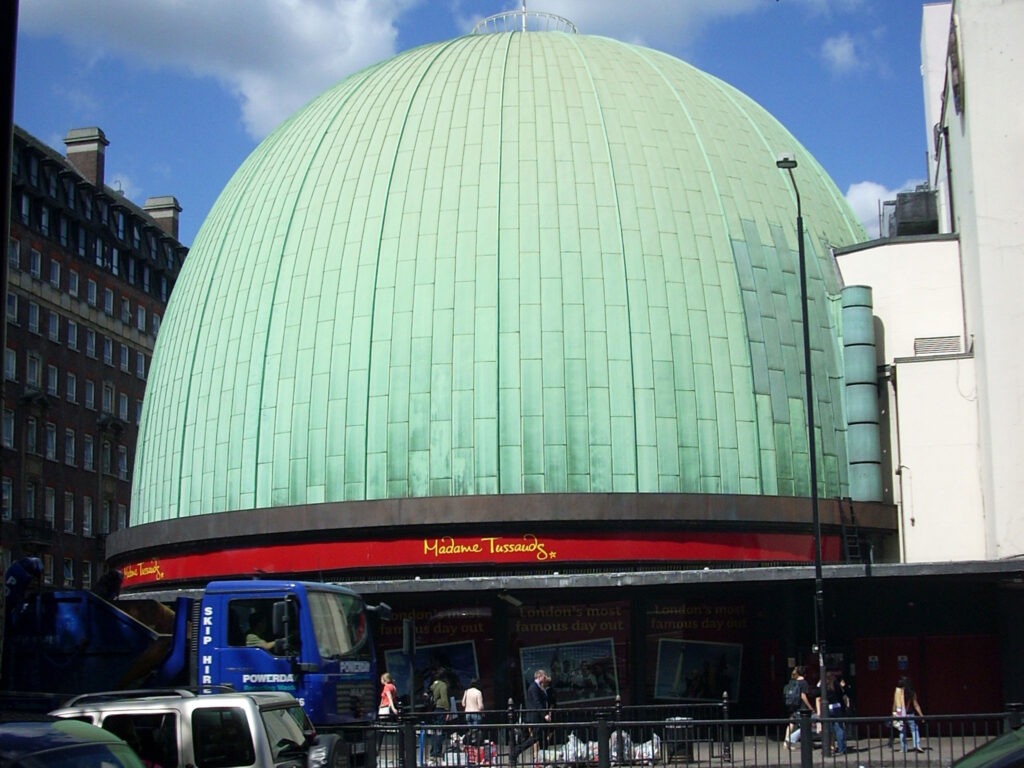
MUZEUM FIGUR WOSKOWYCH MADAME TUSSAUD’S – to muzeum figur woskowych znanych ludzi z rozmaitych dziedzin życia, założone w 1835 przez Marie Tussaud przy Baker Street, niedaleko Muzeum Sherlocka Holmesa. Marie Tussaud przybyła do Londynu w 1835 r. z woskowymi odlewami głów zgilotynowanych w czasie rewolucji francuskiej arystokratów m.in. Marii Luizy, księżniczki de Lamballe, które to stanowiły podwaliny ogromnej kolekcji figur woskowych. Obecnie muzeum Madame Tussauds prezentuje naturalnej wielkości figury gwiazd filmu, muzyki, sportu, rodziny królewskiej. Zwiedzanie tego muzeum trwa zazwyczaj od 1,5 godz do 2 godzin. Cena biletu waha się od 30 do 37 funtów czyli nieco ponad 150 zł.
MADAME TUSSAUD’S MUSEUM – a museum of wax figures of famous people from various walks of life, founded in 1835 by Marie Tussaud on Baker Street, near the Sherlock Holmes Museum. Marie Tussaud came to London in 1835 with wax casts of the heads of aristocrats guillotined during the French Revolution, including Maria Luisa, princess de Lamballe, which formed the basis of a huge collection of wax figures. Currently, the Madame Tussauds museum presents life-size figures of film, music, sports and royal family stars. A visit to this museum usually takes from 1.5 to 2 hours. The ticket price ranges from 30 to 37 pounds, which is the equivalent of around PLN 150.
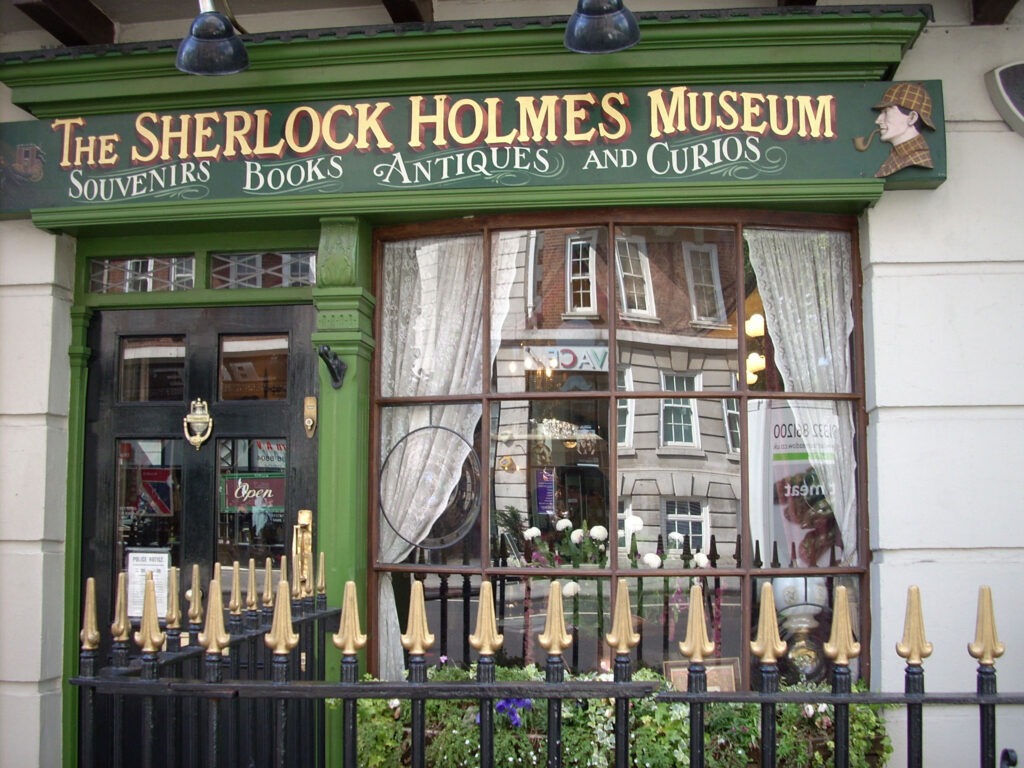
MUZEUM SHERLOCKA HOLMESA – dokładny adres: 221B Baker Street – to oficjalne miejsce zamieszkania bohaterów powieści i opowiadań detektywistycznych Arthura Conana Doyle’a Sherlocka Holmesa i jego przyjaciela – Johna Watsona. Właścicielem domu była pani Hudson. Malutkie lecz urocze miejsce prezentujące artefakty z kart opowiadań Doyle’a.
SHERLOCK HOLMES’S MUSEUM – exact address: 221B Baker Street – this is the official residence of the heroes of Arthur Conan Doyle’s detective novels and stories, Sherlock Holmes and his friend John Watson. Mrs. Hudson was the owner of the house. It’s a tiny but charming place displaying artifacts from the pages of Doyle’s stories.

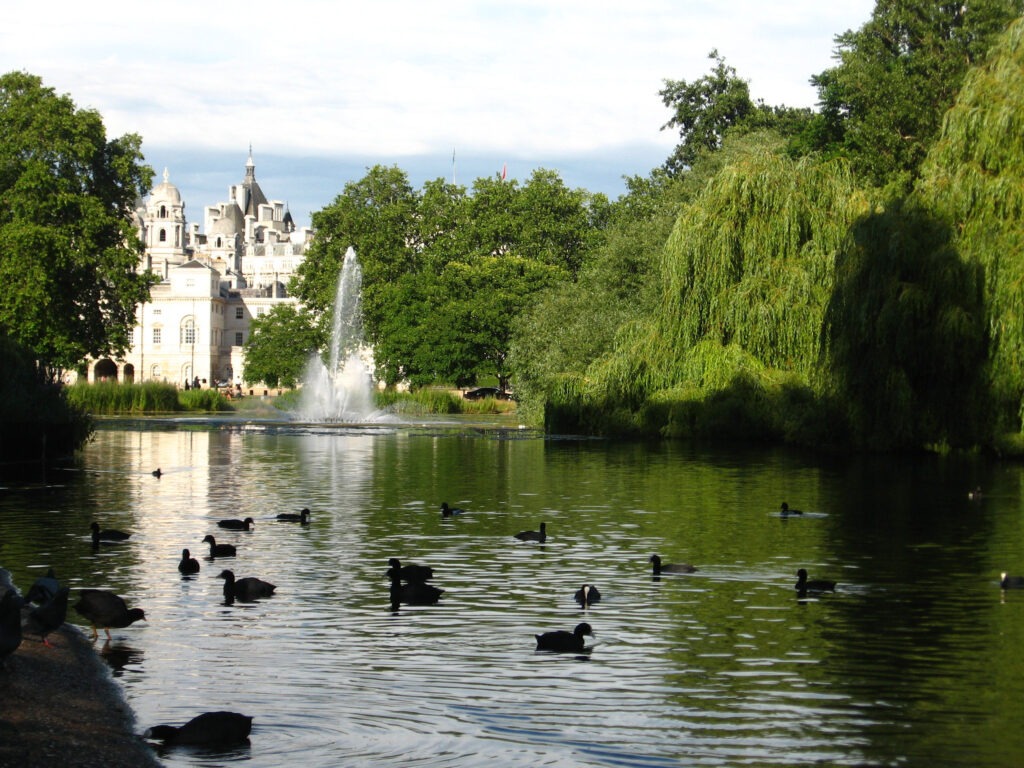
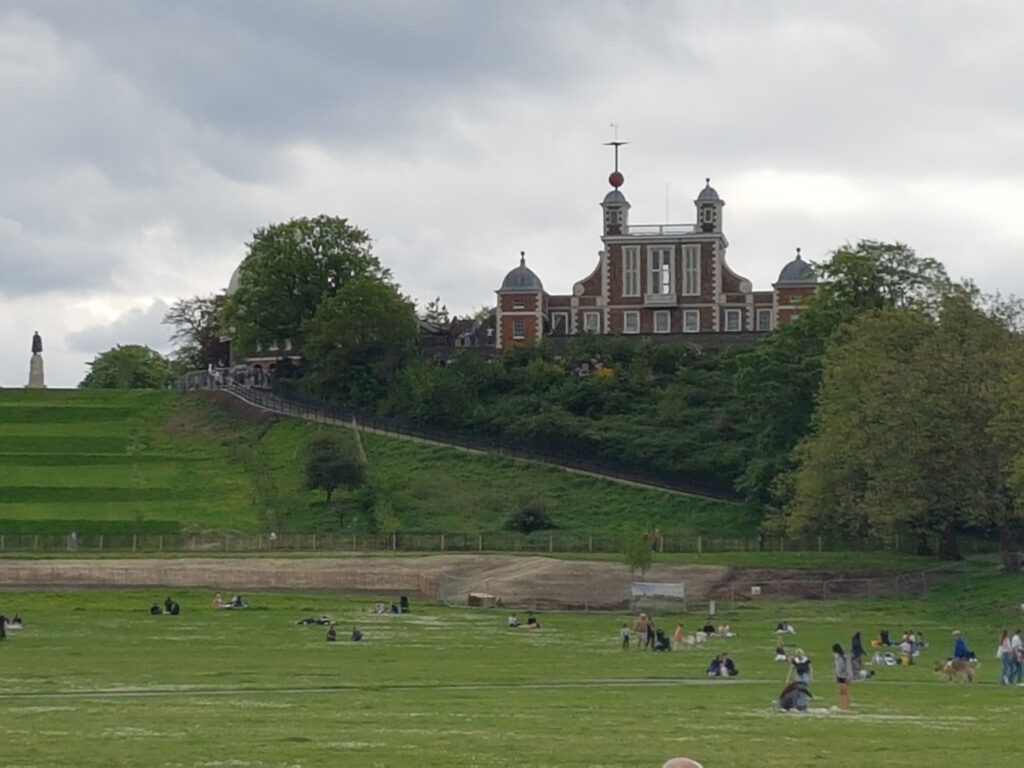
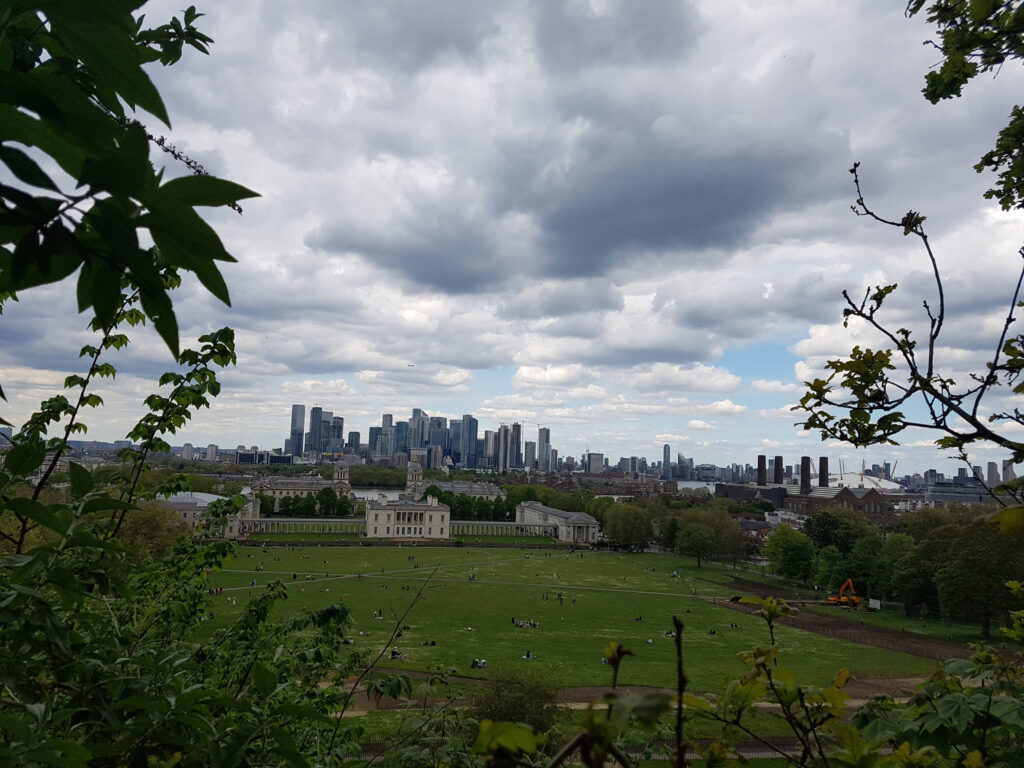
LONDYŃSKIE PARKI
Oprócz okazałych budynków, gmachów, pomników i innych interesujących architektonicznych obiektów, Londyn oferuję również szeroką gamę plenerowych atrakcji które możemy znaleźć w parkach w samym sercu miasta niejako okalających Pałac Buckingham.
Najatrakcyjniejsze parki Londynu to:
HYDE PARK – to jeden z kilku parków królewskich w Londynie, położony w centralnej części miasta, w granicach City of Westminster. Hyde Park zajmuje powierzchnię ok. 159 hektarów i podzielony jest na dwie części przez jezioro Serpentine. Przed parkiem, na rogu północno-wschodnim, znajduje się Marble Arch. Była to oryginalna brama Pałacu Buckingham, która jednak okazała się za wąska dla królewskiej karety i przeniesiono ją w obecne miejsce w 1851r. Miejscem, któremu nazwa Hyde Park zawdzięcza swoje potoczne znaczenie (jako forum dla swobodnego wypowiadania wszelkich poglądów w imię wolności słowa) jest Speakers’ Corner, usytuowany w pobliżu Marble Arch. Jest to tradycyjne miejsce przemówień i debat mających miejsce zwłaszcza w niedzielne poranki. A przemawiali tam m.in. Karol Marks i Włodzimierz Lenin. Hyde Park jest też miejscem koncertów na wolnym powietrzu. Występowali tu m.in. The Rolling Stones, Pink Floyd, Queen, Bon Jovi, Depeche Mode i Madonna.
ST. JAMES’ PARK – to najstarszy z królewskich parków w Londynie, położony w dzielnicy City of Westminster, pomiędzy Pałacem Buckingham, Pałacem Westminsterskim i St. James’s Palace.
St. James’s Park jest wpisany na listę angielskiego dziedzictwa narodowego. Powierzchnia parku wynosi ok. 32 hektary. Przy parku położone są trzy pałace: Pałac Buckingham, Pałac Westminsterski i St. James’s Palace.
GREEN PARK – to kolejny królewski park w Londynie znajdujący się w dzielnicy City of Westminster, pomiędzy Hyde Park i St. James’s Park. Od strony zachodniej Green Park łączy się z St. James’s Park przy pomniku Wiktorii w Queen’s Garden, dokładnie naprzeciwko wejścia do Pałacu Buckingham. Z Green Park widać zachodnie fasady St. James’s Palace oraz Clarence House. The Green Park zajmuje powierzchnię ok. 53 akrów i w przeciwieństwie do sąsiednich parków, w Green Park nie ma żadnych jezior ani pomników, a jedyną fontanną jest Canada Memorial. Park ten składa się głównie z zalesionych polan.
ST. REGENT’S PARK – to czwarty spośród królewskich parków w Londynie zlokalizowany częściowo w City of Westminster, a częściowo w London Borough of Camden. Jego powierzchnia wynosi 197 hektary. Na północy parku znajduje się londyńskie zoo. W 1835, podczas panowania Jerzego IV, częściowo otwarto park dla zwiedzających. W latach 30. XX wieku stworzono w centralnej części parku ogród różany zwany Queen Mary’s Gardens.
RICHMOND PARK – to największy spośród królewskich parków w Londynie, leżący w dzielnicy Richmond upon Thames. Jego powierzchnia wynosi 955 hektarów co czyni go największym ogrodzonym parkiem miejskim w Europie. Richmond Park jest Specjalnym Obszarem Ochrony Siedlisk chroniącym chrząszcza jelonka rogacza. Ponadto żyją w nim liczne inne zwierzęta, w tym jelenie i daniele. Park ten jest również idealnym miejscem dla amatorów ornitologii bowiem można tam napotkać ponad 100 gatunków ptaków.
GREENWICH PARK – to kolejny spośród królewskich parków w Londynie. Jego powierzchnia wynosi 74 hektary. Na niewielkim wzgórzu stoi Królewskie Obserwatorium Astronomiczne zbudowane przez Christophera Wrena z którego rozpościera się ładny widok na okoliczne tereny jak np. Millenium Dome.
W przeszłości park ten służył królom jako teren do polowań z sokołami. Henryk VIII wprowadził tu także jelenie. Jakub I (James I) postawił wokół parku nowy ceglany mur wysoki na cztery metry i długi na dwie mile, którego część nadal wyznacza granice Greenwich Park. Podczas Igrzysk Olimpijskich Londyn 2012 w Greenwich Park odbyły się zawody jeździeckie. Na terenie parku znajduje się również National Maritime Museum, które jest najważniejszym muzeum morskim w Zjednoczonym Królestwie i jednym z największych muzeów tego typu na świecie.
LONDON PARKS
In addition to impressive buildings, edifices, monuments and other interesting architectural objects, London also offers a wide range of outdoor attractions that can be found in parks in the heart of the city, surrounding Buckingham Palace.
The most attractive parks in London are:
HYDE PARK – is one of several royal parks in London, located in the central part of the city, within the boundaries of the City of Westminster. Hyde Park covers an area of approximately 159 hectares and is divided into two parts by Serpentine Lake. In front of the park, on the northeast corner, is Marble Arch. This was the original gate of Buckingham Palace, but it turned out to be too narrow for the royal carriage and was moved to its current location in 1851. The place to which the name Hyde Park owes its colloquial meaning (as a forum for the free expression of all views in the name of freedom of speech) is Speakers’ Corner, located near Marble Arch. It is a traditional place for speeches and debates, especially on Sunday mornings. Among those who spoke here were Karl Marx and Vladimir Lenin. Hyde Park is also a venue for outdoor concerts. The artists who performed here were e.g. The Rolling Stones, Pink Floyd, Queen, Bon Jovi, Depeche Mode and Madonna.
ST. JAMES’ PARK – is the oldest of the royal parks in London, located in the City of Westminster, between Buckingham Palace, the Palace of Westminster and St. James’s Palace. St. James’s Park is an English National Heritage site. The area of the park is approximately 32 hectares. There are three palaces located near the park: Buckingham Palace, Westminster Palace and St. James’s Palace.
GREEN PARK – is another royal park in London located in the City of Westminster, between Hyde Park and St. James’s Park. From the west, Green Park connects with St. James’s Park next to the Victoria Memorial in Queen’s Garden, directly opposite the entrance to Buckingham Palace. From Green Park you can see the western facades of St. James’s Palace and Clarence House. The Green Park covers an area of approximately 53 acres and unlike neighbouring parks, Green Park has no lakes or monuments, and the only fountain is the Canada Memorial. This park consists mainly of forested clearings.
ST. REGENT’S PARK – is the fourth royal park in London, located partly in the City of Westminster and partly in the London Borough of Camden. Its area is 197 hectares. To the north of the park is London Zoo. In 1835, during the reign of George IV, the park was partially opened to visitors. In the 1930s, a rose garden called Queen Mary’s Gardens was created in the central part of the park.
RICHMOND PARK – it is the largest of the royal parks in London, located in the district of Richmond upon Thames. Its area is 955 hectares, which makes it the largest fenced city park in Europe. Richmond Park is a Special Habitat Conservation Area protecting the stag beetle. In addition, there are numerous other animals living there, including deer and fallow deer. This park is also an ideal place for ornithology enthusiasts as you can encounter over 100 species of birds there.
GREENWICH PARK – this is another of London’s royal parks. Its area is 74 hectares. On a small hill there is the Royal Astronomical Observatory built by Christopher Wren, from which there is a nice view of the surrounding areas, such as the Millennium Dome.

KRÓLEWSKIE OBSERWATORIUM ASTRONOMICZNE W GREENWICH – to obserwatorium astronomiczne zaprojektowane przez słynnego architekta – Christophera Wrena na zlecenie króla Karola II w 1675 roku. W późniejszych latach kierowane było m.in. przez Johna Flamsteeda i służyło wówczas do pomiarów astrometrycznych, wykorzystywanych do nawigacji w żegludze dalekomorskiej. Obserwatorium nie prowadzi obecnie prac obserwacyjnych z powodu londyńskiego zanieczyszczenia światłem. W XIX wieku stało się najbardziej znanym obserwatorium świata, gdyż znajdowało się na południku zerowym, od którego liczy się długość geograficzną; wszystkie miejscowości do 180 stopnia na wschód lub na zachód od południka „zero” mają odpowiednio długość wschodnią lub zachodnią.
THE ROYAL GREENWICH OBSERVATORY – an astronomical observatory designed by a famous architect Sir Christopher Wren and commissioned by King Charles II in 1675. In later years, it was managed, among others, by John Flamsteed and was then used for astrometric measurements used for navigation in high-seas shipping. The observatory is currently not conducting observations due to London’s light pollution. In the 19th century, it became the most famous observatory in the world because it was located on the Prime Meridian, from which longitude is calculated; all localities up to 180 degrees east or west of the „zero” meridian have eastern or western longitude, respectively.
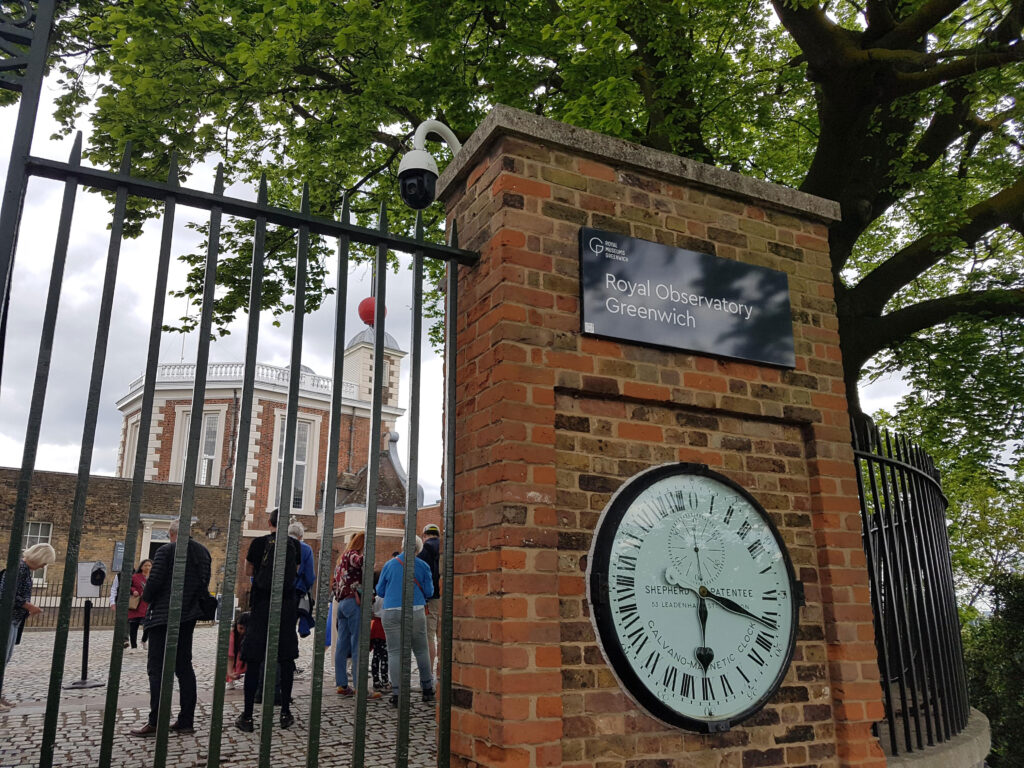
NOTTING HILL – to dzielnica Londynu, leżąca w gminie Royal Borough of Kensington and Chelsea. Uważana jest ona za stosunkowo zamożną i modną, znana z wysokiej klasy restauracji oraz markowych sklepów, a także second-handów. Inną atrakcją turystyczną jest targ na Portobello Road. Notting Hill zyskało światową sławę dzięki Notting Hill Carnival, czyli paradom ulicznym w stylu karaibskim odbywającym się w sierpniu, które przyciągają corocznie setki turystów. Dzielnica zyskała sławę także dzięki hollywoodzkiej produkcji Notting Hill, w której zagrali Julia Roberts i Hugh Grant.
NOTTING HILL – a district of London, located in the Royal Borough of Kensington and Chelsea. It is considered relatively affluent and fashionable, known for its high-class restaurants and brand stores, as well as second-hand stores. Another tourist attraction is the market on Portobello Road. Notting Hill gained worldwide fame thanks to the Notting Hill Carnival, a Caribbean-style street parade held in August that attracts hundreds of tourists every year. The district also gained fame thanks to the Hollywood production Notting Hill, starring Julia Roberts and Hugh Grant.
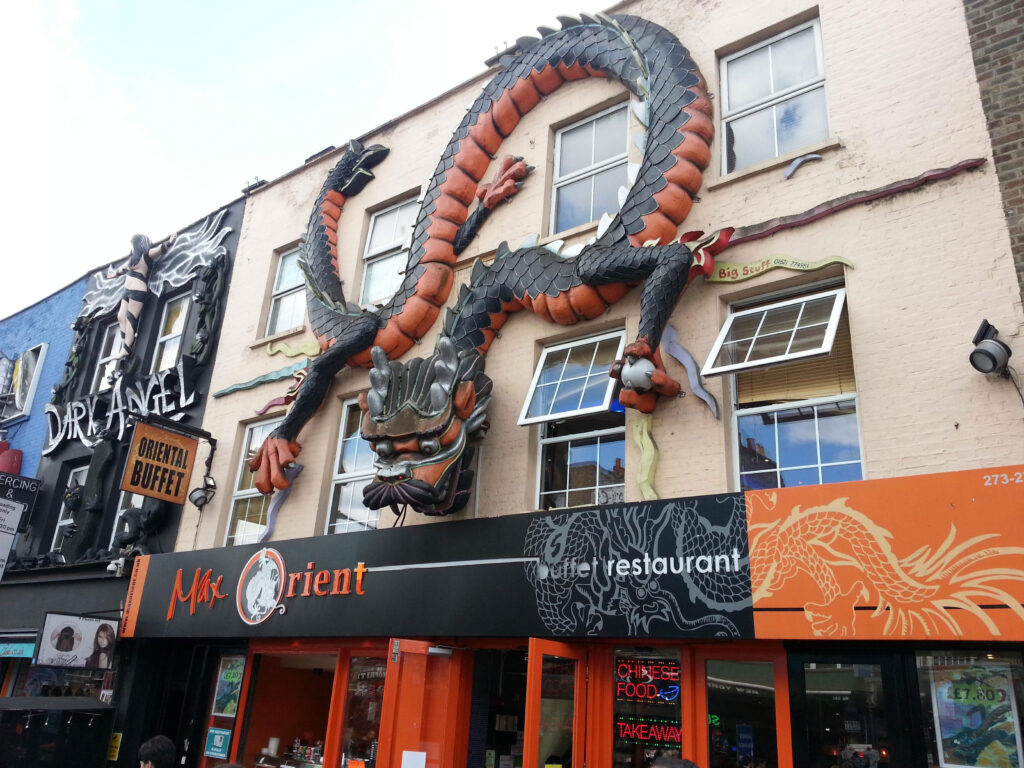
CAMDEN TOWN – to dzielnica w północnej części Wewnętrznego Londynu, w centrum gminy London Borough of Camden, założona jako dzielnica mieszkalna w 1791 i położona nad Regent’s Canal. Dzielnica odgrywała ważna rolę w czasach początku rozwoju kolei a jej przemysłowe dziedzictwo dało zalążek do rozwoju handlu i rozrywki, w tym wielu sławnych na świecie bazarów np. Camden Market i scen muzycznych związanych z kulturą alternatywną. Camden Town jest znane ze swojego targu stanowiącego centrum mody i ekstrawagancji. Całe miejsce utożsamiane jest z kontrkulturą, szczególnie popularna wśród turystów, nastolatków i punków. Życie nocne kwitnie tu do późnych godzin i obejmuje muzykę na żywo w alternatywnych klubach i pubach typu oldschool.
CAMDEN TOWN – a district in the north of Inner London, in the centre of the London Borough of Camden, founded as a residential district in 1791 and situated on Regent’s Canal. The district played an important role in the early days of railway development, and its industrial heritage gave rise to the development of trade and entertainment, including many world-famous bazaars, e.g. Camden Market, and music scenes associated with alternative culture. Camden Town is famous for its market, which serves as a fashion and extravagance hub. The whole place is associated with counterculture, especially popular among tourists, teenagers and punks. The nightlife here lasts until late and includes live music in alternative clubs and old-school pubs.

JAK PORUSZAĆ SIĘ PO LONDYNIE
Londyn jest świetnie skomunikowany. Po mieście kursują charakterystyczne czerwone autobusy zwane double-deckers, czyli dwupokładowce, którymi można dojechać praktycznie w każdy zakątek miasta. Jeszcze lepszym wyborem zwłaszcza w godzinach szczytu stanowi metro zwane w Londynie The Tube ze względu na swój kształt. Londyńskie metro jest najstarsze na świecie a pierwsi mieszkańcy mogli z niego korzystać w 1863 roku. Obecnie metro posiada 11 linii, około 270 stacji a całość trasy obejmuje dystans 402 kilometrów. Z tego systemu korzysta codziennie ponad 3 miliony podróżnych. System płatności za metro jest niezwykle wygodny bowiem nie trzeba kupować papierowych biletów, wystarczy, że odbijemy własną kartę płatniczą przy wejściu i wyjściu z metra. Właśnie tzw. podwójne odbicie karty jest istotne bowiem jeśli tego nie uczynimy to podróż może nasz dużo kosztować, ponieważ na tej podstawie kalkulowany jest dystans, który następnie jest przeliczany na należną kwotę. Jeśli decydujemy się na dłuższy pobyt w Londynie np. długi weekend i więcej to warto nabyć tzw. Oyster card, którą możemy doładowywać w automatach znajdujących się przy bramkach wejściowych do metra. W przypadku jednodniowego pobytu można również skorzystać z Day Travelcard również dostępną w automatach.
Oprócz transportu publicznego, charakterystycznymi pojazdami w mieście są czarne taksówki, potocznie nazywane black cabs.
HOW TO GET AROUND LONDON
London has excellent transport links. There are characteristic red buses called double-deckers running around the city, which can take you to virtually every corner of the city. An even better choice, especially during rush hours, is the underground, called The Tube in London due to its shape. The London Underground is the oldest in the world and the first residents could use it in 1863. Currently, the Tube has 11 lines, approximately 270 stations and the entire route covers a distance of 402 kilometers. More than 3 million travelers use this system every day. The underground payment system is extremely convenient as you do not have to buy paper tickets, you just need to print your own payment card when entering and leaving the Tube. Just the so-called double tapping of the card is important because if we do not do it, the trip may cost us a lot, because on this basis the distance is calculated and then converted into the amount due. If we decide to stay in London for a longer time, e.g. a long weekend or more, it is worth getting the so-called Oyster card, which can be topped up at machines located at the Tube entrance gates. For a one-day stay, you can also use the Day Travelcard, also available from vending machines. In addition to public transport, the characteristic vehicles in the city are black taxis, commonly called black cabs.
GDZIE NA ZAKUPY
Londyn słynie z bycia stolicą mody a ulice miasta to prawdziwy pokaz mody. Wszystkie style są dozwolone i widoczne na każdym kroku. Najsłynniejszym i najlepszym miejscem na zakupy wydaje się być Oxford Street rozpoczynająca się od Marble Arch przy Hyde Parku. Jest to jednoczenie jedna z najdłuższych ulic w mieście gdzie usytuowane są różnego rodzaju sklepy, domy handlowe jak słynny The Selfridge’s, butiki, restauracje, kawiarnie itd. Z pewnością każdy znajdzie tu coś dla siebie. Innym miejscem wartym odwiedzenia w celach zakupowych jest centrum handlowe Westfield w Stratford gdzie mieści się ponad 250 sklepów. Dobrym atutem jest lokalizacja tego miejsca, bowiem można tam wygodnie i bezpośrednio udać się choćby na lotnisko Stansted lub centrum Londynu.
Dla bardziej wymagających klientów z zasobniejszym portfelem, znanym miejscem jest historyczny i luksusowy dom towarowy Harrods znajdujący się przy Brompton Road, w dzielnicy Knightsbridge. Historia tego zabytkowego obiektu sięga 1849 roku kiedy to Henry Charles Harrod otworzył pierwszy rodzinny sklep. Obecny 7-piętrowy budynek pochodzi z 1905 roku i wygląda niezwykle okazale a jego bogato zdobione wnętrza, wręcz pałacowe, naprawdę robią wrażenie. Asortyment towarów jest równie bogaty bowiem można tu kupić dosłownie wszystko, od pocztówek i innych pamiątek po drogie produkty znanych światowych marek. Od 1959 roku dom towarowy należał do spółki House of Fraser. W latach 1985-2010 Harrods był własnością braci Al-Fayed (Aliego i Mohameda, ojca Dodiego Al-Fayeda), którzy kupili sieć House of Fraser wraz z Harrodsem. W 2010 Harrods został sprzedany spółce Qatar Investment Authority powiązanej z katarską rodziną królewską.
Dla tych którzy lubią robić zakupy na wolnym powietrzu zwłaszcza jeśli chodzi o unikatowe przedmioty, ciekawymi opcjami są takie miejsca jak Greenwich Market, Covent Garden, Camden Market czy Portobello Road.
WHERE TO DO THE SHOPPING
London is famous for being the capital of fashion and the city streets are a real fashion show. All styles are allowed and visible at every step. The most famous and best place for shopping seems to be Oxford Street starting from Marble Arch in Hyde Park. At the same time, it is one of the longest streets in the city where there are various types of shops, department stores such as the famous The Selfridge’s, boutiques, restaurants, cafes, etc. Everyone will certainly find something for themselves here. Another place worth visiting for shopping is the Westfield shopping center in Stratford, where there are over 250 shops. A good advantage is the location of this place, because you can conveniently and directly get to Stansted Airport or the centre of London.
For more demanding customers with larger wallets, a well-known place is the historic and luxurious Harrods department store located on Brompton Road, in the Knightsbridge district. The history of this historic building dates back to 1849, when Henry Charles Harrod opened the first family shop. The current 7-storey building dates back to 1905 and looks extremely impressive, and its richly decorated, almost palatial interiors are truly imposing. The range of goods is equally wide as you can buy literally everything here, from postcards and other souvenirs to expensive products of well-known international brands. From 1959, the department store belonged to the House of Fraser company. From 1985 to 2010, Harrods was owned by the Al-Fayed brothers (Ali and Mohamed, Dodi Al-Fayed’s father), who bought the House of Fraser chain together with Harrods. In 2010, Harrods was sold to the Qatar Investment Authority, which has links to the Qatari royal family.
For those who like to shop outdoors, especially when it comes to unique items, interesting options include Greenwich Market, Covent Garden, Camden Market and Portobello Road.
CO I GDZIE ZJEŚĆ W LONDYNIE
Zapewne większość osób przybywających na Wyspy nie ma dobrego wyobrażenia o kuchni brytyjskiej lub wręcz mieszane uczucia jednak gdy wybierzemy właściwe miejsce może się okazać, że jest to najlepszy kierunek aby posmakować kuchni i dań z wielu stron świata przyrządzanych na najwyższym poziomie. Moje kubki smakowe podbiły ostatnio dania z kuchni tureckiej i arabskiej oraz śródziemnomorskiej, która niezmiennie cieszy się dużym powodzeniem i takich restauracji nie brakuje w Londynie. Jednym z takich miejsc jest restauracja Sefa w londyńskim Greenwich specjalizująca się w daniach tureckich i śródziemnomorskich. Wszystko świeże, dobrej jakości składniki i przede wszystkim zdrowe. Odnośnie typowych dań w Wielkiej Brytanii nie sposób nie wspomnieć o tradycyjnych fish and chips czyli smażonej rybie z frytkami (najczęściej jest to haddock czy łupacz).
Godnym polecenia miejscem jest Trafalgar Tavern tuż nad Tamizą w urokliwej dzielnicy Greenwich. Sam budynek przyciąga swą niezwykłą architekturą i stylem, jego wnętrze wzbudza jeszcze większe wrażenie, a dopełnieniem są niezwykle smaczne posiłki.
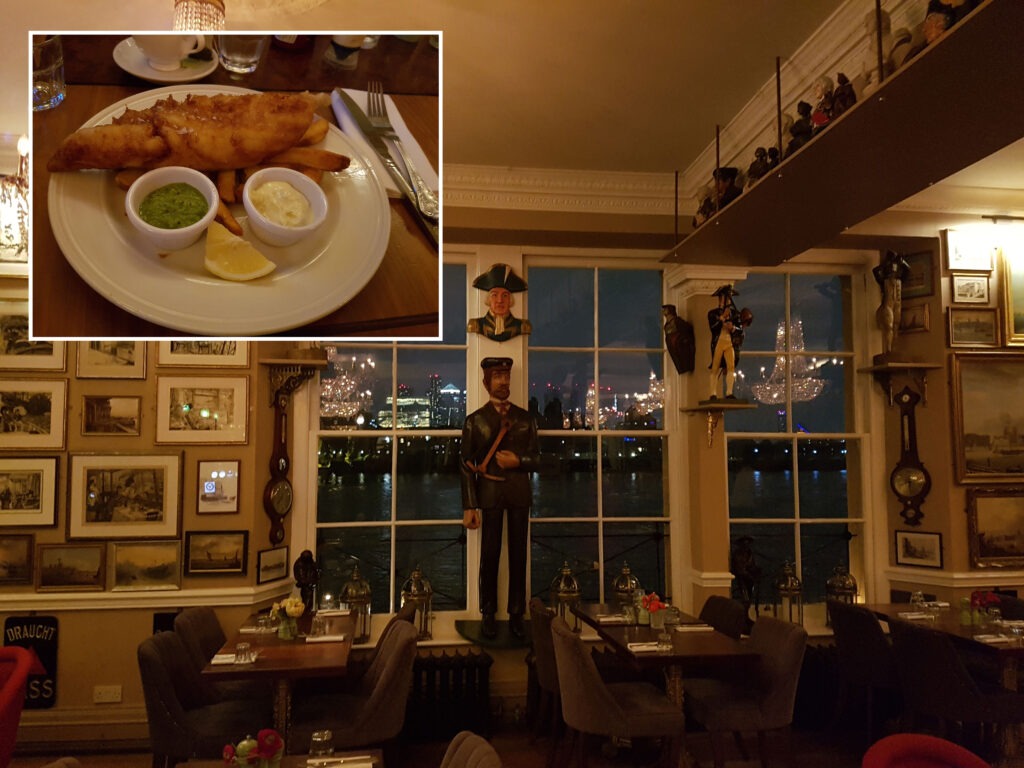
WHAT AND WHERE TO EAT IN LONDON
Most people who come to the British Isles probably have no good associations with British cuisine or even have mixed feelings, but when we choose the right place, it may turn out that it is the best destination to taste cuisine and dishes from many parts of the world prepared at the highest level. My taste buds have recently been conquered by dishes from Turkish, Arabic and Mediterranean cuisine, which is always very popular and there is no shortage of such restaurants in London. One such place is the Sefa restaurant in London’s Greenwich, specialising in Turkish and Mediterranean dishes. Everything is fresh, with good quality ingredients and, above all, healthy. When it comes to typical dishes in Great Britain, it is impossible not to mention the traditional fish and chips.
A place worth recommending is the Trafalgar Tavern right on the Thames in the charming Greenwich district. The building itself attracts with its unique architecture and style, its interior is even more impressive, and it is complemented by delicious meals.
PODSUMOWANIE
Jak widzimy lista z charakterystycznymi miejscami wartymi odwiedzenia w Londynie jest dość pokaźna i zwiedzanie tej największej angielskiej metropolii może okazać się męczące jednak jedno pozostaje pewne… Londynem nie sposób się znudzić bo jak stwierdził Dr Samuel Johnson „When a man is tired of London, he is tired of life” (Kiedy ktoś jest znudzony Londynem, to znudzony jest życiem). Ja bynajmniej nie znudziłam się jeszcze londyńskim klimatem w pełnym tego słowa znaczeniu i na pewno jeszcze nie raz tam powrócę.
SUMMARY
As we can see, the list of characteristic places worth visiting in London is quite extensive and visiting this largest English metropolis may be tiring, but one thing remains certain… It is impossible to get bored with London because, as Dr. Samuel Johnson said, „When a man is tired of London, he is tired of life”. I am by no means bored with the London atmosphere in the full sense of the word and I one day will definitely return there again.

